




The Joffrey Ballet introduces a quartet of new company members.






The Joffrey Ballet introduces a quartet of new company members.
03 Feral Citizen An excerpt from Nance Klehm’s The Soil Keepers

05 Restaurant Review Dim sum and win some at Lincoln Park’s D Cuisine

07 Joravsky | Politics A Sun-Times reporter gathers the FBI’s files on the famous and infamous.

08 Juvenile Lifer In 2016, more than 2,000 adults who were sent as kids to die in prison were given a second chance. Marshan Allen was one of them.
12 Lit Everything Must Go pays tribute to Wicker Park’s displaced working class; On Division follows a devout Jewish mother reconciling her faith with her Hasidic community’s cruelty to her late son.
14 Visual Art Artist Adela Goldbard draws from Mexican traditions to address issues in Little Village today.
15 Dance The Joffrey Ballet introduces a quartet of new company members; American Catracho puts Wilfredo Rivera’s immigrant story on its feet.
17 Review King Hedley II brings Old Testament fury to Pittsburgh; The

King’s Speech looks good, but the drama is inert at Chicago Shakes.
18 Plays of note Oslo illuminates the behind-the-scenes machinations of Middle East diplomacy; Hello Again offers a daisy chain of lusty interludes.
21 Review Rick Alverson’s The Mountain is a fascinating but ultimately frustrating mood piece.
22 Movies of note The Cat Rescuers documents the heroic acts of Brooklyn cat people; Misty Button is brimming with witty dialogue and colorful characters; and the drama in Send Me to the Clouds feels canned.

24 Galil | Feature Chicago’s beat scene has to do without the kind of attention devoted to the

city’s rappers, but it serves as a vital incubator for adventurous, ambitious instrumental hip-hop.
29 Shows of note Hyde Park Jazz Fest, Nick Cave, Fire-Toolz, and more this week
32 The Secret History of Chicago Music Little-known blues-rock wizard Zach Prather has found his crowd in Europe.
34 Early Warnings Calexico, Pile, Tierra Whack, and more justannounced concerts
34 Gossip Wolf Grün Wasser diversify their apocalyptic EBM on Not OK With Things, the Chicago South Side Film Festival celebrates house music, and more.
36 Savage Love Dan Savage says your Republican dad’s crossdressing isn’t something you need to talk about with him.
38 Jobs
38 Apartments & Spaces
38 Marketplace

TO CONTACT ANY READER EMPLOYEE, E-MAIL: (FIRST INITIAL)(LAST NAME) @CHICAGOREADER.COM
PUBLISHER TRACY BAIM
EDITORS IN CHIEF SUJAY KUMAR, KAREN HAWKINS
DEPUTY EDITOR KATE SCHMIDT
CREATIVE LEAD SUE KWONG
DIRECTOR OF PHOTOGRAPHY JAMIE RAMSAY
MUSIC EDITOR PHILIP MONTORO
THEATER AND DANCE EDITOR KERRY REID
ASSOCIATE EDITOR JAMIE LUDWIG
SOCIAL MEDIA EDITOR BRIANNA WELLEN
SENIOR WRITERS DEANNA ISAACS, BEN JORAVSKY, MIKE SULA
STAFF WRITERS MAYA DUKMASOVA, LEOR GALIL
EDITORIAL ASSOCIATE S. NICOLE LANE
LISTINGS COORDINATOR SALEM COLLO-JULIN
FILM LISTINGS COORDINATOR PATRICK FRIEL
DIGITAL REPORTING INTERN AARON ALLEN
CONTRIBUTORS NOAH BERLATSKY, LUCA CIMARUSTI, ISA GIALLORENZO, MADELINE HAPPOLD, JACK HELBIG, IRENE HSIAO, DAN JAKES, MONICA KENDRICK, MEGAN KIRBY, STEVE KRAKOW, JAMIE LUDWIG, MAX MALLER, BILL MEYER, J.R. NELSON, OLIVER SAVA, LEAH PICKETT, BEN SACHS, KATHLEEN SACHS, DMITRY SAMAROV, CATEY SULLIVAN, IZZY YELLEN
DIRECTOR OF DIGITAL JOHN DUNLEVY DIRECTOR OF PUBLIC ENGAGEMENT & PROGRAMS KRISTEN KAZA OFFICE MANAGER SORAYA ALEM ADMINISTRATIVE ASSISTANTS
JANAYA GREENE, YAZMIN DOMINGUEZ
ADVERTISING
312-392-2970, DISPLAY-ADS@CHICAGOREADER.COM
CLASSIFIEDS: SALEM@CHICAGOREADERCORP.COM
SALES DIRECTOR PATTI FLYNN
VICE PRESIDENT OF SALES AMY MATHENY CLIENT RELATIONSHIP MANAGER TED PIEKARZ SENIOR ACCOUNT REPRESENTATIVES
BOB GRIFFITH, JORI LIEFSCHULTZ, LENI MANAAHOPPENWORTH, ALEX RAY, LISA SOLOMON CLASSIFIED SALES MANAGER WILL ROGERS
NATIONAL ADVERTISING
VOICE MEDIA GROUP 1-888-278-9866
VMGADVERTISING.COM
JOE LARKIN AND SUE BELAIR
DISTRIBUTION CONCERNS distributionissues@chicagoreader.com 312-392-2970
STM READER, LLC
BOARD PRESIDENT DOROTHY R. LEAVELL TREASURER EILEEN RHODES
SECRETARY JESSICA STITES AT-LARGE SLADJANA VUCKOVIC
CONSULTANT CAROL E. BELL
READER (ISSN 1096-6919) IS PUBLISHED WEEKLY BY STM READER, LLC 2930 S. MICHIGAN, SUITE 102 CHICAGO, IL 60616 312-392-2934, CHICAGOREADER.COM


Our environment is shaped by what we choose to observe. But while our most abundant products are waste, these by-products of our activities are so plentiful and often so strangely formed it is either di cult or impossible to contemplate them, let alone safely hold or fold them into a substrate that is able or willing to digest them.
Many industrial cities worldwide operate combined sewage-stormwater systems, largely built at the tail end of the 19th century in response to outbreaks of cholera and dysentery.*






By NANCE KLEHM
At a time when the word “organic” defines responsible living and municipalities wring their hands over soil contamination, stormwater management, and the overtaxed sewer system, how do we put two and two together and harvest the rich minerals and organisms present in our waste streams? Working with waste challenges cultural taboos, as well as presenting as an environmental risk. But sane, safe, low-tech systems for processing waste also present a real solution to reconnecting our bodies to earth. All we have to do is first pull out the thorn of ingrained prejudice.
Large connected sewage systems in Chicago, Paris, and Hanover, Germany, were some of the first built, and therefore are some of the modern world’s oldest and most in need of repair. Folding in additional infrastructure for expanding populations, repairing tunnels, and/or replacing more than 150-yearold pipes (many of them lead) and tunnels is an expensive and complicated operation. Chicago has been at work on its plumbing infrastructure for decades—repair, expansion, and maintenance is an ongoing process.
Black water from toilets, gray water from bathtubs, showers, and sinks, stormwater (including everything it catches as it flows over streets, parking lots, roofs, lawns, and sidewalks), as well as contaminated water from factories where manufacturing or material processing happens—it all ends up at the wastewater treatment plant at some point. In fact, sewers were designed to receive and treat stormwater first and foremost, and are referred to as “stormwater conveyance systems” by professionals, as the volume of stormwater processed is many times of that which we flush.
The primary treatment is mechanical by nature. Water passes through slotted grates where coarse materials over several inches are caught, collected, and landfilled. The water then rests in large settling tanks for several hours until light solids (including grease) float and are skimmed o and landfi lled. Heavy solids sink and become primary sludge, which is then sent to a centrifuge where extra water is spun out and sand, gravel, co ee grounds, etc, are landfi lled.







to cannabis; ticket required, space is limited)
continued from 3
The water from the settling tank then enters secondary treatment, in which air is pumped into the tank to stimulate aerobic bacteria to consume the remaining organic matter suspended in the mixture. Over several hours, as the bacteria eat, more sediment falls out and settles into the tank. The water is then disinfected, usually by adding chlorine, then discharged as “e uent” into a natural waterway. Some of this secondary sludge is used as an inoculant to “seed” the next batch of wastewater with a population of aerobic bacteria. But most of it passes to a biodigester where it produces both oxygen and methane, which is then used for heat and electricity. The e uent from this digestion is then “dewatered” by another centrifugal process to create biosolids, and the resulting water is then returned to the treatment plant for reprocessing and discharged.
The biosolids are mixed with waste carbon (usually wood pulp) and are windrowed to be thermophilically composted and made available as soil amendment or mulch. As recently as a few years ago in Chicago, these biosolids did not enter a composting process. Instead they were heat dried or pasteurized to remove moisture and kill off pathogens, then amended with organic polymers to improve their consistency. There has been both celebration and uproar around the use of biosolids to help revegetate mining tailings, remediate a brownfield into a park, a golf course, or a housing development, etc. The Clintons had them spread in the White House garden; the Obamas had them removed.**
The by-products of human living have great potential for reuse as soil amendment or biogas creation resulting in healthier water, air, and, yes, soil for us all. But whether because that potential is invisible or simply too unpalatable, that potential remains largely untapped. Maybe it doesn’t have a profit margin, is seen to be dangerous, or would require us to unhinge our brains to allow some new impulses to fi re. Regardless, we will stay in these nongenerative, damaging, disconnective patterns we have designed and encoded into our lives unless we recognize the gold that lies in the dung heap.***
Notes:
*At the end of 2018, it was reported that 40 percent of deaths in Pakistan are due to dysentery.






Annually, the city of Chicago sends out an extended water report to every mailbox in the city. Over the years I have noticed that contamination rates in the water supply have increased, though we are assured that they are still within safe levels by EPA standards—as these standards continue to be incrementally increased so we can clear the limbo bar as our systems age. With every human-designed energy system there is entropy or a downcycling that occurs and a need for a discharge of liquid and solid material that can’t be treated any further. Combined sewer overflows usually occur in wet weather when treatment plants fi ll to capacity. To relieve pressure, excess flow is released into open waters that we share with every citizen and the rest of life’s creatures.
**There are different rules for different classes of biosolids. Class A biosolids contain no detectable levels of pathogens. Class B biosolids are treated but still contain detectable levels of pathogens. Meaning class A biosolids have passed through a thermophilic composting process that kills off pathogens where class B biosolids have not. The use of grade of biosolid, whether A or B, brings with it rules of amount that can be used, type of use of the site it is used on (capping a landfill or mine tailings, to fertilize crop land or community garden, as a turf amendment in a public park or residential backyard). Pathogens aside, many of these biosolids contain various heavy metals and dioxins that escape the treatment of the municipal wastewater facility. Only recently has it been proposed to limit the concentration of dioxin and dioxinlike compounds.
***While mining sewage sludge is being looked at to grab the precious metals—namely nickel, copper, platinum, iron, zinc, silver, and, yes, gold (from electroplating, electronics manufacturing and automotive catalysts)— the economics have not proven worth the hassle. v
Nance Klehm’s The Soil Keepers: Interviews With Practitioners on the Ground Beneath Our Feet (Terra Fluxus Publishing) is available for purchase at spontaneousvegetation.net as well as locally at Women and Children First and Marz Community Brewing Co.
-360 -7239 dcuisinechicago.com
Yum cha is fine at this rare tearoom outside of Chinatown, but it’s the Guangdong chef specials that are really worth investigating.
By MIKE SULA



Tuesday, October 1, marks the 70th anniversary of the People’s Republic of China, a milestone that Hong Kong—under British rule at the time—doesn’t share. In the 48 years before the colonizer turned the island back over to the mainland and up until the present, Hong Kong has maintained its own identity, not a small part of which is its standing as the world capital of Cantonese food—probably the most internationally recognizable regional Chinese cuisine among so many. And that’s also definitely true of its particular subset of dim sum, the ritualized brunch of tea and small bites also known as yum cha
But in fact, no matter how much solidarity we feel for democracy-driven protesters currently getting gassed and clubbed by police and (possibly) Beijing-supported thugs, the practice of yum cha originated on the mainland, in roadside tearooms in Guangzhou, where Cantonese food is known—as it is everywhere else in China—as Guangdong cuisine, named for the surrounding province.
Danny Fang, the owner of Lincoln Park’s D Cuisine, is from Guangzhou, as is his chef, Fang Yu. Does that make any di erence in the
dim sum he serves every day from 8 AM to 11 PM on North Clark Street?
I’m not so sure, but the bright storefront restaurant does have one key distinction: it’s the only tearoom in the nearly six miles that separate Furama in Uptown and Shanghai Terrace downtown. It’s even more of a stretch considering that, apart from Streeterville’s Grandee Cuisine, all the city’s credible dim sum is clustered in Chinatown like siu mai packed in a bamboo steamer, including stalwarts such as Cai, Chiu Quon, Dim Dim, Dolo, Phoenix, and MingHin. Fang worked at the last for close to a decade as a server, but shrewdly chose to parlay his experience in the middle of a dim sum desert.
More so than regional di erences, the question on everyone’s mind when it comes to the dumplings, buns, rolls, cakes, and pastries that make up the universe of dim sum is whether they’re prepared in-house or stamped out en masse, frozen, and trucked to the back door by some outside vendor before they’re steamed or fried, stacked, and then dutifully wheeled out on pushcarts through crowded dining rooms.
Fang threw down a glove when D Cuisine opened in early June, not just for the loca- J


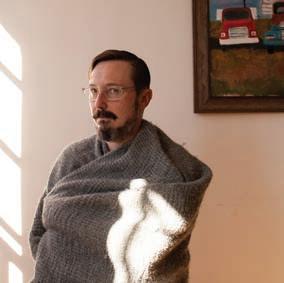

continued from 5
tion he chose, but for the promise of dim sum made in-house daily. That may be the case, but I experienced such a variety in execution among the bites I tried that it sometimes made the effort seem irrelevant. One afternoon’s deep-fried taro pu s and minced pork dumplings served at room temperature created a crime scene of fryer oil and darkened the collective mood of a table full of fressers with the default disposition of crankiness when it comes to Chinese food. Panfried shredded taro cakes were so embedded with five spice powder that they may have cross-contaminated the chubby siu mai, perfuming the tensile shrimp forcemeat and the tobiko roe crown. I’m afraid it fogged their mirror on the rest of the meal. For me, I thought much of what crowded the table was perfectly executed in the context of the neighborhood. Panfried corn cakes stuffed with chunks of snappy shrimp straddle the breakfast-appropriate sweet and savory divide, while jiggly chicken feet and honeyed short ribs assertively favor the former side. Fat shrimp dumplings enrobed in chewy dough, unctuous steamed spare ribs, and vegetable-stuffed sheets of tofu skin all could pass inspection in Chinatown. And not all dishes are fried with reckless abandon: seaweed-wrapped krab sausages in a crunchy batter jacket have more snap than a Vienna Polish. In total, D Cuisine’s dim sum, given its coordinates and 15-hour availability, deserves its pushpin on the city’s Cantonese map.
But what the restaurant really has going for it are Yu’s Guangdong chef specials. These include a superb Guangzhou-style whole roasted chicken, with crispy burnished skin and flesh from thigh to breast gravid with unreleased juices waiting to burst forth. A log pile of asparagus is shrouded in a gossamer veil of egg white and crabmeat. In one Yu original, a generous pile of nutty wild rice is wok-tossed with minced beef and glutamate-bombed with savory XO sauce; a glossy-sauced casserole of mustard greens and planks of crunchy Chinese



yam (aka cinnamon vine) is possessed by the same five-spiced ghost that haunts the menu in so many unexpected places. You’re meant to eat that rice in scoops of iceberg lettuce, but much later that night I found myself introducing the two leftovers to each other in my own wok, and enjoyed the rest of the darkness free of the usual terrors.
Besides these, there are still novelties to be found throughout D Cuisine’s larger menu of Cantonese classics and a small representation of Ameri-Chinese standards, such as a platter of salt-and-pepper-fried “Causeway Bay Style Jumbo Shrimp.” Named for Hong Kong’s teeming shopping district, they’re tossed with dried red chiles, shredded iceberg lettuce, and crushed soda crackers, as if the British never left.
It doesn’t say much of anything that D Cuisine is serving the best dim sum in Lincoln Park—if not the whole north side. But dishes such as those make the restaurant a rare place of reward for Cantonese food outside of Chinatown. v
@MikeSula
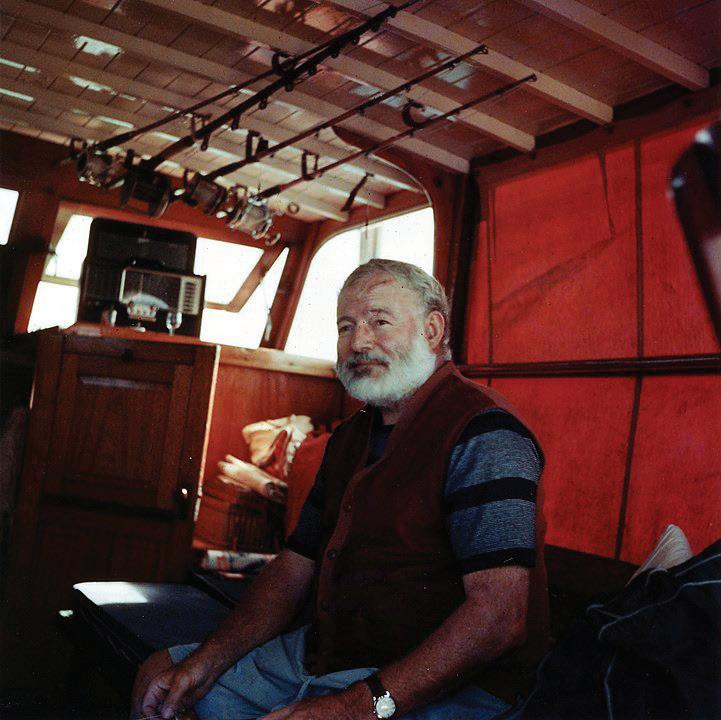
A Sun-Times reporter gathers the FBI’s files on the famous and infamous.
By BEN JORAVSKY
There are many ways to honor great writers—award them prizes, name streets for them, or best of all, buy and read their books.
To that list let me add another: Open a secret file and fill it with info gathered by the FBI.
This is my way of saying that I’ve spent the better part of the last couple of days plowing through pages of FBI files on famous and infamous Chicagoans gathered by Bob Herguth, intrepid investigative reporter for the SunTimes . (You can page through it yourself by going to the Sun-Times website.)
Before I dig deeper into what I found, a word or two about Mr. Herguth.
The dude’s a little, oh, I wouldn’t say kooky
According to the FBI’s fi les, Ernest Hemingway tried to convince the agency that he saw a German submarine off the coast of Cuba during World War II.
More like obsessive. And I say this with all due respect as someone kooky enough to spend 15 years (and counting) writing about TIFs.
A few years back Herguth decided to gather some FBI files, and he’s been methodically gathering them ever since. Think of it as his hobby. Hey, man, it beats fantasy football. He’s gathered files on mobsters, church leaders, politicians, and activists including Mayor Richard J. Daley, organized crime boss Sam Giancana, Muhammad Ali, Congressman Abner Mikva, and so on and so forth. He’s got 125 files and counting, with more coming in all the time.
If you want to know more about Herguth and his quest, check out our recent conversation from my podcast.
Apparently, the FBI will turn over a file so long as the subject is dead. Though parts of many files are blacked out, and I wouldn’t be surprised if they omitted the real good stu altogether.
As I said, I’ve spent the better part of several nights reading through them, and I got a little dizzy from staring at the screen. I went straight to the writers. Mainly, I wanted to see what a writer had to do to get the FBI’s attention. Apparently, not much.
The FBI had a file on Mike Royko, the great columnist who died in 1997. In it was a copy of a letter from someone in Cleveland, upset over a 1969 column in which Royko chastised the FBI for spreading salacious dirt on Martin Luther King Jr.
Writing directly to then-FBI director J. Edgar Hoover (man, I’d love to see his file), the reader in Cleveland says: “I am sending you some clippings you may want to read . . . I am with you one hundred percent on everything you do . . . I would love an autographed picture of you if possible, to put over my fireplace.”
Guess the Royko reader in Cleveland figured it would pay to butter Hoover up. It worked, as Hoover’s response is also in the file: “I am forwarding . . . one of my photographs, which I have autographed to you. I am returning the communications you send since I know you would want to keep them.”
You know, just in case the Royko reader in Cleveland wants to hang it over the fireplace with Hoover’s autographed picture.
The Sun-Times also has the FBI file on Ernest Hemingway (he was born in Oak Park, so that makes him a Chicagoan, more or less).
The funniest parts are when some unknown agent describes Hemingway’s unsuccessful efforts to convince the FBI that he saw a German submarine o the coast of Cuba, where he was living during World War II.
The agent was skeptical in part because Hemingway “is known to have personal hostility to the FBI on an ideological basis, as he considers the FBI anti-Liberal, pro-Fascist and dangers as developing into an American Gestapo.”
Say this for Hemingway—he was never shy about speaking his mind. Even to the FBI.
Not surprisingly, the FBI also snooped on
Saul Alinsky, the radical activist of the 50s and 60s, who literally wrote the book on organizing (make that two books—Rules for Radicals and Reveille for Radicals).
An unidentified FBI agent filed a report based on a speech Alinsky delivered in 1969 in Rhode Island: “A confidential source who has furnished reliable information in the past . . . stated that ‘the talk was rambling and disjointed with the basic theme of obtaining power through community action’ and by ‘inciting municipal jitters’ to gain financial goals for the impoverished.”
That sure sounds like Alinsky.
The agent goes on to write: “Alinsky at one point stated, ‘It isn’t that I don’t like the establishment, I hate their guts.’”
My guess is the feeling was mutual.
Reading through the files reminded me of a story I heard years ago from the late Paul Newey, an investigator for the Cook County state’s attorney’s o ce.
Newey knew all about the FBI and its files due to the years he’d spent in law enforcement. Near the end of his life, he was diligently digging through some files on a Chicago gangster when, to his dismay, he discovered a report from an FBI agent about ties between well-known gangsters and Mayor Richard J. Daley’s chief corruption investigator.
The gangsters were talking about killing Newey because his investigations were getting too close.
When he read the report, Newey was outraged because 1) the mobsters were talking about killing him; 2) Mayor Daley’s chief corruption investigator was, in fact, a confederate of the very mob he was supposed to be investigating; 3) the FBI knew all of this and never bothered to tell him; 4) all of the above.
I wrote a story about Newey—which I urge everyone to read. After that, the FBI probably opened a file on me.
I’ll bet they have one on Herguth, what with all his poking around in their business.
Perhaps years from now one of Herguth’s as-of-yet-unborn grandchildren—who shares that Herguth journalistic gene—will send in a request to the FBI, secure grandpa’s file, and deposit it on the Sun-Times site. Which, by then, will no doubt include several thousand dossiers.
That would put Herguth right up there with Royko, Hemingway, and Alinsky—pretty good company to keep.
Keep up the good work, Bob. v @joravben
In 2016, more than 2,000 adults who were sent as kids to die in prison were given a second chance. Marshan Allen was one of them.
By DYLAN WALSH
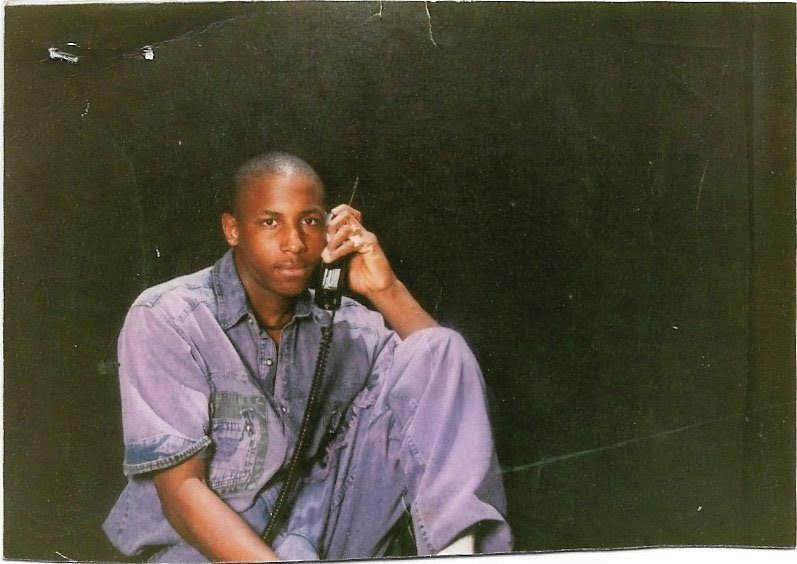
Marshan Allen emerged from prison in clothes unfit for the midwestern winter: a standard-issue gray hoodie and sweatpants, a pair of slippers. He boarded a van that drove him to the front parking lot of Stateville Correctional Center. It was December 2016, and 40 miles northeast rose the orange glow of Chicago. The van slowed to a stop. The door opened. From the huddled welcome party of family and friends and lawyers came a shout: “Hallelujah Jesus!”
His mother was fi rst to embrace him. It was di erent from all those times she’d held him in shadowless visitation rooms. To her, it felt like giving birth again. “Let’s go,” Allen said as they walked to his mother’s minivan, “before they change their minds.”
Allen had spent years imagining this night, the unshackled ride beyond the gates into some new future, the tremendous scrutiny he
would fi x on the landscape scrolling past as if that alone could somehow accelerate experience and o set the quarter century he had lost. Instead, he spent his time craned over a smartphone. He swiped the screen. He made calls. I’m out, he told people. In 1994, he’d been given two sentences of mandatory life without the possibility of parole for a crime he committed at the age of 15. He’d been condemned to pass adolescence, adulthood, and old age in maximum-security prison. Death would be his liberation. Now here he was.
The small caravan departed Stateville and stopped at Allen’s new rental apartment. He checked in with his parole officer while his family cleaned and talked, and then they left.
The landlord, an old friend, had put Allen’s utilities in order and furnished the bedroom and an office, but the place was otherwise empty.
Prison had been punishment by absence,
and, besides family, it was simple pleasures that Allen had missed: fi shing, driving, washing cars, sleeping in, mowing the lawn. He had missed baths, and had long envisioned a bubbly soak on his fi rst night home. He fi lled the shallow tub, lowered himself in, and closed his eyes under the fluorescent light. He couldn’t sleep after the bath, so he called his high school friend Simone Bowles and sat at a computer as they talked. He toured East Chatham, his old neighborhood, on Google Street View. He visited his grandmother’s house, not far from the scene of the crime, and then returned to the scene itself. He and Bowles wandered the past together. “The weirdest thing was, it all seemed normal,” he told me of that fi rst night back. He’d expected to feel like an alien, adrift, or disoriented. But nothing about freedom was strange. “I felt like I went to sleep and woke up.”
In 2005 the U.S. Supreme Court ruled five to four that capital punishment is unconstitutional for crimes committed before the age of 18. “The reality that juveniles still struggle to define their identity means it is less supportable to conclude that even a heinous crime committed by a juvenile is evidence of irretrievably depraved character,” wrote Justice Anthony Kennedy. “The State can exact forfeiture of some of the most basic liberties, but the State cannot extinguish his life and his potential to attain a mature understanding of his own humanity.”
Though the ruling hinged on a single vote, it provided the logical groundwork by which criminal justice advocates could chip away at the next-harshest punishments targeting youth. In 2010, the Supreme Court agreed that life without parole was impermissible for a juvenile convicted of any crime besides homicide. And in 2012, in Miller v. Alabama,
mandatory life without parole for juveniles was abolished.
Evan Miller was raised by an alcoholic and drug-addicted mother, an abusive father, and the foster care system. From an early age he was an addict. He fi rst attempted suicide in kindergarten; three more attempts followed. Then, at the age of 14, he pummeled his mother’s drug supplier with a baseball bat and lit his trailer on fi re. (The man died from his injuries and smoke inhalation.) Miller, who was drunk and high at the time of the crime, was tried as an adult, found guilty of murder, and sentenced, by statutory mandate, to life without parole.
When Allen was young and his Aunt Rosetta visited she would toss him the keys to her gold BMW. He would slip out of the house and sit in the car listening to the radio. During summers and on school days when he ditched class at Emil G. Hirsch Metropolitan High School, Allen helped a man named Doc repair cars behind his house. He rebuilt engines, installed brakes and transmissions, and sometimes sold drugs. He would also occasionally steal cars from his neighborhood, joyride for an hour, then ditch them nearby assuming word would get back to the owner— but not, he said, before washing the cars and filling them with gas. If he and his friends were well enough organized, they would make o in a convoy of stolen cars and play tag by tapping bumpers.
Allen grew up poor, but not unhappy. “I had no supervision, no curfew, I could come and go as I pleased, especially after I got my car,”
The court, again in a five-to-four opinion, recognized universally “mitigating qualities of youth” in the details of Miller’s upbringing: kids are immature, reckless, and dependent on family, for better or worse. “Incorrigibility is inconsistent with youth,” wrote Justice Elena Kagan in the majority opinion. State law could no longer mandate a life sentence for juveniles, as such “punishment disregards the possibility of rehabilitation even when the circumstances most suggest it.” A 2016 decision made this retroactive. Suddenly eligible for a second chance were 2,200 adults sent as kids to die in prison.
he told me in one of several conversations. Allen bought a maroon 1984 Chevy Impala with an inheritance from his grandmother’s death. “No one would ask where I’d been. No one asked why I wasn’t at school, and the school didn’t call home. At the time I thought it was the coolest thing ever.” He now sees this as dysfunctional and has come to recognize greater strains from childhood—his uncles’ ascendance in the Gangster Disciples, his family’s legacy drug business and addictions. Allen sold drugs to his aunts and delivered them to his mother. He left his mom’s apartment, in South Chicago, at the start of high school and moved in with his grandmother, three miles away on 79th Street. This was near the rental apartment out of which his brother, James, ran a lucrative drug business, and for whom Allen ran errands, delivered packages, picked up buyers, and dropped them o .
According to court documents and testimony, on March 11, 1992, Allen drove to get Myron Gaston, a regular buyer, and two of Gaston’s friends. He took them back to his brother’s apartment, where they purchased



$2,800 worth of cocaine, then pulled a gun and robbed James of money and an additional four ounces of cocaine. When the robbery was over, Allen obediently completed his duties as chau eur, driving the men back to the corner where he’d picked them up, wondering whether they would let him live.
A few days later, after a string of failed negotiations with the robbers at a White Castle, James asked Allen to steal a Chevy Astro van and, the next morning, Allen climbed into the back seat with one of James’s acquaintances, Darnell Dixon. Behind the wheel was Eugene Langston, who set a sawed-o shotgun on the floor. The three men made their way to Gaston’s apartment, parked around the corner, and climbed a back stairwell. Langston handed Dixon a .45 caliber handgun, then knocked on the door.
To Allen, the stolen van, the ride-along with Dixon and Langston, even the weapons, all marked a campaign grounded in that fundamental if rough-cut Old Testament variety of fairness: steal back what’s stolen. “I don’t remember anyone talking about killing,” Allen told me.


For too many women, violence, economic insecurity and lack of access to health care are de ning parts of their story.
Join Chicago Foundation for Women as we change the story in Chicago by investing in basic rights and equal opportunities for all women and girls.
Hear Elaine Welteroth share how she ipped the script and made an impact on the next generation through her work as an award-winning journalist, author, and former Editor-in-Chief of Teen Vogue
Tickets + sponsorships available at www.cfw. org/luncheon.




















Langston leveled the shotgun, fi red twice, then kicked down the door. Allen heard more gunshots as he fled. He waited in the van until Dixon and Langston returned, then the three drove away and ditched the van. Dixon left to meet his girlfriend. Langston and Allen returned to James’s apartment, where Allen monitored his brother’s police scanner. Voices soon confi rmed two dead.
Allen learned that the Gangster Disciples, the gang Gaston belong to, had spread word to kill him and his brother, so the two of them fled the city in a rented Lincoln. They looped around the southern shore of Lake Michigan, then sped east to Detroit, where they could sit out time with the family of James’s girlfriend.
One week into hiding, Allen turned 16. He walked down the block and bought a half gallon of strawberry ice cream at an Amoco gas station and enjoyed it by himself. In early April, he and James returned to Chicago. They never discussed the crime.
Allen was arrested on April 4. The cops came to his mother’s house, roused him from bed at midnight, and drove him to the District Five police station, where he was interrogated by detectives in a small room. By midmorning, he’d signed a statement drafted by the assistant state’s attorney, Henry Simmons, that outlined his crime. Allen was shuttled to juvenile detention to await trial, and 11 months later, on his 17th birthday, he was transferred to Cook County Jail. He remembers a stopover at the courthouse where an employee gave him a cupcake with a single lit candle, wished him happy birthday, and let him call his mother.
Allen’s first trial ended with a hung jury. One of the jurors found the mandated sentence of life without parole too severe. The prosecutors brought the case again in June 1994, imbuing Allen with the criminal motivation of vengeance. Because of Illinois’s law of accountability, it didn’t matter whether Allen had pulled a trigger or even possessed a gun. Accountability “is like a blanket that spreads out over the criminal activity,” the prosecutor explained in his closing statement. By stealing the van, Allen “placed himself under the blanket.” Nor, the prosecutor continued, should Allen’s youth overshadow or soften the viciousness of the murders. The judicial lines of reasoning that animated Miller v. Alabama were still years away. “Whether it is a 16-year-old, a criminal mind is a criminal mind nonetheless, and it acted like a crimi-
nal mind,” said the prosecutor. This time all the jurors agreed.
He was sent to the maximum security Pontiac Correctional Center. He sought refuge with the Gangster Disciples, who knew his uncles well and embraced him in their prison bureaucracy. This proved a comforting familiarity. Fresh in Allen’s mind was mess hall, where signs lined the walls (“Sit down when shots fired”) and a corrections officer surveyed the room while holding an M14.
Allen assumed a job on the bottom of the gang’s hierarchy as a “gallery coordinator.” He canvassed his caseload, collecting legal concerns, informal complaints, and formal grievances into a weekly report. He learned to research legal cases in the prison library and he tracked the progress of his own appeal, which was in the hands of a lawyer bankrolled by his brother.
Allen was 18, the enforcement of prison rules was lax, and James soon began to mail him packages of marijuana. He collected the drugs from another inmate at the law library or in the yard. Selling was easy, and he was soon rich with goods from commissary and other homespun crafts offered in exchange for the drugs.
In January 1997, Allen was transferred to Stateville Correctional Center. Six months later James was killed in a motorcycle crash on Chicago’s southwest side, at the sunken S-curve of Interstate 57 below the 107th Street overpass. Allen’s lawyer then dropped his case, guards caught him with marijuana, and he was sent to solitary for six months. As Allen grieved for his brother, he could feel himself slipping into a hole. He sat alone in his cell, the fi xed anchor of his life sentence weighing even more heavily. Soon after his release back to the general population, he was transferred to X House.
X House, which had been home to inmates on death row when Illinois still practiced capital punishment, was intimate relative to other wings, housing 80 men rather than hundreds. Though raised Baptist, Allen had never read the Bible, which he’d grown up knowing as the white man’s book. But haunted by those the state had killed and in search of guidance, he shrugged o this preconception and enrolled in a class on Catholicism. He began to question the prayers for release he had long whispered to God. What interest did God have in letting him go, Allen thought, if he wasn’t living life as he should? And if he were somehow granted release, whether by
divine or earthly intervention, would he even recognize what this looks like—living life as he “should”?
Shortly after this, Allen resigned from the Gangster Disciples, enrolled in a paralegal training course, and, in November of 2001, received his certificate. He enrolled next in a two-year curriculum on small business management. He pushed for transfer to a medium-security prison, where educational opportunities were comparatively bountiful. In 2007, the request was granted. At Western Illinois Correctional Center he started taking classes o ered by Lake Land College. Among several subjects, accounting proved most irresistible. He disappeared for hours in the subtle interpretation of numbers. Because the prison had no pencil sharpeners outside of the classroom, he carried two dozen presharpened pencils back to his unit and stayed up late at an empty table in the common area laboring over his homework. He tracked stocks, matching their rise and fall against his readings of Bloomberg Businessweek , the Wall Street Journal, Barron’s , and Kiplinger’s Personal Finance. He underlined and dog-eared his copy of the Morningstar Complete Investor, and he devised a fictional portfolio that outperformed the 401(k) of his Lake Land professor, Ronald Frillman. Then he realized he could legally make his own investments, so he pulled together a few hundred options and pored over annual reports and SEC fi lings. He sought to model his decision-making on the inspired farsightedness of his new idol, Warren Buffett, whose self-exile from Manhattan and San Francisco to the quiet of Omaha resonated with Allen and his own involuntary exile.
Allen put $150—all he had—into CVS stock. He had never stepped foot inside of a store. But he knew that most of the company’s revenue came from its pharmacy, and this seemed like a stable bet. The fact that CVS had a smaller market share than Walgreens gave it greater room for growth, he reasoned.
“Plus,” he said, “I’m a fan of the underdog.”
Years after he’d purchased the stock, riding on a prison transfer bus passing through Champaign, Illinois, Allen saw a CVS through the mesh cage of the window. He nudged the man beside him and said he owned a brick or two of the store.
“Stop and think for a moment about the remarkable thing that occurred,” Frillman told me. “Here’s somebody who has been locked up since he was 16, without a high school edu-
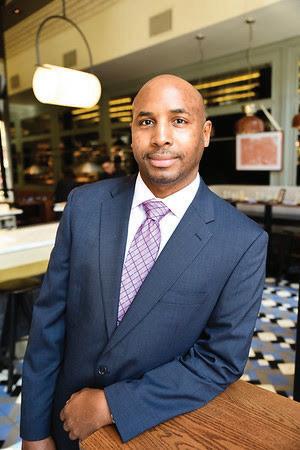
cation. He’s got a life without parole sentence and instead of ‘oh, woe is me,’ he thinks: How do I get my GED? How do I get my paralegal certificate? Can I get transferred to pick up more classes because they don’t o er them at this prison? Can I get an associate’s degree, a BA?” Frillman paused. “If he wanted, I’d adopt him.”
Meanwhile, the world of law, a strange cousin to accounting with its distinct vernacular and byzantine rules, became Allen’s second refuge. When he had first arrived at Pontiac, older prisoners taught him the basics of legal research. Once he no longer had legal representation, Allen spent long days at the library exploring the details of his case. In 2003, he secured a job as a law clerk in Stateville prison. Three years later, the Illinois State Bar Association recruited him to help write Post-Trial Remedies: A Handbook for Illinois Prisoners. He started fi ling for postconviction relief on the grounds that the initial police interrogation had violated his rights and that he’d not received e ective assistance of counsel.
Allen’s appeals failed and failed and failed, and he continued to file. “He will not stop fi ghting,” a public defender, Crystal Carbellos, who represented him during his 2016 resentencing hearing, told me. “He is unwilling to stop fi ghting.” Nearly two decades after he was fi rst arrested and jailed, the courts fi nally responded in Allen’s favor. When he wrote an article for the prison newspaper, Stateville Speaks, he titled it “The Sixteenth Time’s a Charm.”
As Allen’s individual disposition began to change, so too did the broader politics of juvenile punishment. He watched the Supreme Court in 2005 ban the death penalty for anyone under 18. He had come to understand that law changed incrementally, and that capital punishment was, by necessity, the fi rst step in dismantling the next-harshest youth sanctions. Repealing mandatory life without parole for juveniles was not far down the list, and seven years later came Miller v. Alabama, which did just that.
In March 2014, the Illinois Supreme Court decided that Miller would apply retroactively. Roughly 80 men and women across the state sentenced to mandatory life without parole as juveniles were eligible for a resentencing hearing. (Some states ruled Miller was not retroactive; the Supreme Court settled this state-by-state discrepancy in 2016.) Allen, by that time, had been transferred to Danville Correctional Center, where he was pursuing classes through the local community college.
That spring, Allen remembers the first truly nice day of the season, stepping into the prison yard and drifting to the solitude of its southeast corner. Beyond the chainlink fences and concertina wire was a small manmade lake. It was the fi rst time Allen had seen a body of water since getting locked up. There were a few men seated in a flat-bottomed boat, chatting over the putter of the motor. Allen’s mother had instilled in him a love of fi shing that, for years, he’d nurtured with subscriptions to Bassmaster Magazine, In-Fisherman , and Indiana Game & Fish . He sat out there in the calm and watched the men cast their lines, wait, talk, reel in, cast again.
In April 2015, Allen moved back to Cook County Jail to await his resentencing date. He worked as a tutor and showed 19- and 20-year-old inmates how to carry numbers when doing addition along with the basics of spelling and reading.
He was called to the courthouse in November 2016. Allen sat at a table with Carbellos, his appointed attorney. His family filed in behind him. The prosecutors argued he was not ready for release. Character witnesses on Allen’s behalf rose to take the stand and argue the contrary. Carbellos choked up while presenting her closing statement. “Why? Because of the number of years Marshan lost,” she told me. “He should’ve grown up like other kids grow up. He should’ve fi nished high school. He should’ve
gone to college, had a girlfriend and a wife and a family with kids. He lost 25 years of his life. And what’s amazing to me is that his experience has not jaundiced him toward people, toward life, even toward the judicial system.”
The judge sent Allen home with time served. “Would you like it in days, or years, or months?” Carbellos asked him when it came time for the formal sentencing. Days, said the judge. “9,008.” Allen sobbed, his head on the table, as his family cheered. And yet, as pure as the happiness should have been, it was not untainted by the sense that he was leaving men behind. He considered himself lucky— lucky that he was a juvenile at the time of the crime, lucky that his sentence was mandatory and not discretionary, and lucky that these two factors made him eligible to walk free when so many others remain in prison with no possibility of release.
This is the strange and muddy legacy left by the Supreme Court: only mandatory life without parole for a juvenile was deemed unconstitutional. It remains within a judge’s power to sentence juveniles to life without parole. Sentencing relief also applies only if the crime was committed before one’s 18th birthday; 18-year-olds and 19-year-olds are ineligible. States are struggling to answer a new question too: How many years qualifies as a “de facto” life sentence? Can a juvenile be sentenced to 100 mandatory years? What about 70? Judges and legislators are working through this morbid actuarial logic. An April 2019 ruling in Illinois drew the line at 40 years: below that is acceptable, above qualifies as a life sentence.
Before his release, Allen received a psychological evaluation at Cook County Jail. The psychologist noted that he had been sentenced to 49 years—under Illinois law, he owed half of this, which amounted to time served—and the psychologist wanted to make sure Allen didn’t harbor any suicidal thoughts. He told her he was in fact elated with the sentence because it meant he was going to be released. “And then the more I thought about it, the more it made me angry. I’d been locked up for 25 years and no one decided to give me a psych evaluation then,” Allen said. “Y’all never cared about me and how I was developing mentally, whether or not I’d been a ected—never once gave me a psych evaluation. Now I’m on my way home and you want to give me a psych eval?”
On a Monday morning, he was ushered through the outtake process at Stateville; sometime in the evening he was pulled J


A conversation with Hope Wiseman, and other leading experts, about the business of cannabis. Museum of Contemporary Art. 17 October 2019

aside and told his release had been delayed. (A spokesperson from the Department of Corrections said the delay was “part of the offender’s master file and deemed confidential.”) His family had rented a party bus and waited in the lot with close friends and lawyers. Allen’s mother brought a sandwich and Reese’s Peanut Butter Cups, Kit Kats, and potato chips. Allen never showed. The ride back was silent.
That night in his cell he tried to imagine what had gone wrong. “I felt cheated,” he said. “These people, they already took all these days and years and stu from me, and
which was di erent still from the sound of a big fi sh hooked and starting to fi ght. Twice the bells rang for something big, and twice he reeled in catfi sh.
Allen is now two and a half years out and married. He lives south of the city, in Richton Park, with his wife. He is a program director at the Restore Justice Foundation, a Chicago-based criminal justice advocacy group. He works closely with Northwestern’s Bluhm Legal Clinic, and has also enrolled at Northeastern Illinois University to fi nish his bachelor’s in criminal justice policy and advocacy.
Allen is 43 years old, but is sometimes, briefly, animated by the spirit of adolescent Marshan, somehow preserved inside the man who was in prison. It occurs like a possession.
A certain subject rises and Allen fills with self-doubt, vulnerability, even naivete.


“These people, they already took all these days and years and stuff from me, and now you just took another day. You just got another day from me. And it might not seem like a lot, but it was my day.”
—Marshan Allen
now you just took another day. You just got another day from me. And it might not seem like a lot, but it was my day. It was mine. It was supposed to be mine. I wasn’t supposed to spend that night there. I was supposed to be at home with my family.”
In 2017, while working at Starbucks, Allen filled his spare time with spontaneous fishing trips. One day in early July, after the heavy morning rains suddenly quit, he packed three rods, a tackle box, and folding chairs into his trunk, then drove to buy bait and ice before heading to a nearby nature preserve. “Unexpected fishing trip goes perfectly right,” he said.
He had three lines out at once and on each line he’d attached a fishing bell. He said he knew what the bells sounded like when they rattled in the wind, and it was di erent from the sound of a small fish tugging the line,
Allen bears his personal story openly as both cautionary tale and evidence: though people tend to describe what he accomplished while in prison, and since, as exceptional, he views himself as an example. “Not the exception, the example,” he says. He sees thousands of people behind bars whose personal journeys to reform and remorse go unrecognized, people whose potential for creation rather than destruction goes squandered.
And amid everything sits an unsettling paradox not lost on Allen. As much as he despises the institution of prison in its current form—the violence and grimness and hopelessness and lack of opportunity, its manifestation of racism and intimations of slavery, all of that—it is something to which he also admits a troubling debt of gratitude.
“The people I left behind, the people from the streets, and the people I’ve met and become friends with since, all of these people who are a part of my life now—it never would’ve happened if it weren’t for prison,” he said. “It kind of hurts to think about that.”
These days he spends his time researching possible changes to laws. He writes memos. He meets with state legislators to encourage them to realize a more lenient and restorative system of justice in Illinois. Not long ago, Allen was on his way home, entering the tunnel of Millennium Station, when his phone rang. It was Justice P. Scott Neville Jr. of the Illinois Supreme Court, who had become a mentor and performed his wedding rites, checking in. Allen stopped for a moment. He stared at the screen as strangers streamed by, his world frozen as he considered where he was and who was calling. v
@dylancwalsh
Everything Must Go pays tribute to the displaced working-class of Wicker Park.
By TAYLOR MOORE
Kevin Coval’s poetry has always focused on the margins of identity and community. Tackling subjects like his Jewish upbringing and structural racism, the self-styled breakbeat poet has drawn inspiration from working-class Chicagoans and people of color whose stories were not often told.
Coval’s last book, A People’s History of Chicago, ambitiously aimed to tell the story of Chicago in 77 poems, and his follow-up collection two years later, Everything Must Go (Haymarket Books), tackles another topic close to his heart—gentrification. Specifically, the gentrification of Wicker Park, once a working-class neighborhood and hotbed of young artistic talent. It’s now one of the most expensive communities in the city and, many would say, a skeleton of what it once was. Before he was artistic director of Young Chicago Authors, cofounder of the slam
poetry competition Louder Than a Bomb, and an instructor at UIC, the poet was a scrappy kid from the suburbs who moved to Wicker Park in the mid-90s when it was still a blue-collar, predominantly Latino and eastern European neighborhood. Like many other creative spirits at the time, he was attracted by the cheap rent and burgeoning arts and culture scene. “Wicker Park was my announcement—really even to myself—that [being a writer] was the life I wanted to pursue,” Coval says.
But the connection runs even deeper than that. His grandfather had first moved to Wicker Park in 1906, about 90 years prior to Coval. “My whole life has revolved around the neighborhood. It’s been painful to see it shift in such a way that—like, I can’t live here anymore.” (A studio in Wicker Park will now cost you $2,700 a month.)
Coval had been wanting to write a book about Wicker Park for a long time, but it wasn’t until artist Langston Allston came into the picture that the idea became a reality. The two met at Allston’s 2017 show, “When People Could Fly,” on the history of Chicago public housing. Allston’s work had a “realism that hinted at a comic book love,” Coval says.
They first worked together on “Milwaukee Avenue,” a long stand-alone poem published in chapbook form last year. It was their “mixtape,” as Coval puts it. Allston’s work is interspersed throughout Everything Must Go, from portraits of neighborhood mechanics (“The Saviors of El Barrio”) to full-page illustrations of Coval’s old apartment at 1108 N. Hermitage.
“Wicker park’s a quinoa wrap / a lite grain, a lite beer, a small brewery / a facsimile of what it used to be,” Coval writes. Coval says that the first sign he noticed that the neighborhood was changing was the closing of co ee shop and beloved “third place” Urbus Orbis in 1998. (It’s now the site of an expensive gym.) The second sign was when MTV’s The Real World was filmed in Wicker Park in 2001—a move that was met with protests and has been blamed for hastening gentrification in the neighborhood.
Coval cut his teeth at weekly open mikes hosted by Urbis Orbis and other coffee shops, indie bookstores, and dive bars. You could go to the “six-way”—the intersection of Milwaukee, Damen, and North—on any day of the week and see something going on. Some of those businesses and organi-
By Kevin Coval and Langston Allston (Haymarket Books)
zations, like the Guild Literary Complex and Subterranean, are still a training ground for young artists today, but other centers for the community were eventually priced out of the neighborhood.
In his collection, Coval pays tribute to those neighborhood mainstays, like Cafe Matou and Lit X, and some of its best-known residents, including local rapper Sharkula and the late poet Oba Maja. But he focuses most on the working-class Wicker Parkers who were displaced—the mechanics, barbers, waitresses, the tamale guys.
For them, there’s a “constant threat of removal,” Coval says. And when that happens, “you have an erasure of working-class people and stories in the city.”
As a resident of New Orleans—a city still undergoing gentrification post-Hurricane Katrina—Allston sees these forces happening in real time. “It’s not really that alien of a concept to read through [the book] and imagine the neighborhood changing, because I watch my community change constantly.
“As artists, we’re always looking for this way to freeze the neighborhood we came into, in the way that we came into it,” Allston adds. “And then you watch it start to change and you watch the things you love about it disappear, because the things you love about it are the parts that aren’t viable under capitalism.”

Some would argue that the low-income white artists who moved into the neighborhood were themselves a gentrifying force— and with that comes a recontextualizing of people’s experiences coming of age in Wicker Park. This sentiment is reckoned with explicitly in former Reader contributor Jessica Hopper’s memoir Night Moves (2018), which followed the music critic’s life in Wicker Park and Ukrainian Village in the early-to-mid 2000s, when the neighborhood was still relatively a ordable.
Coval evinces the same grief—and guilt—in conversation. “We were a part of the plan, unbeknownst to us,” he says. But even as he acknowledges that gentrification is a complex, systemic force, he thinks it can be mitigated at the individual level through small actions like supporting local businesses and public schools.
Even as the neighborhood has become almost unrecognizable to longtime residents, you can still see some vestiges of old Wicker Park, Coval says. Many of the dive bars are still intact, for example. And Sharkula still slings mixtapes on Milwaukee Avenue more than 20 years later.
For Brian Wharton, who goes by Sharkula and Thingamajig, Wicker Park was essential in his journey as a hip-hop artist. “I worked two jobs just to fulfill my habit of wanting to get cassettes out,” he says. All of the best record stores, clubs, and parties were in Wicker Park. “It was just exciting to be able to breakdance and pop-lock in a circle amongst the greatest breakdancers, beat boys, pop-lockers.”
His old hangout spots—Lava Lounge, the Pontiac, the Blue Note—are no longer around, though, and neither are the rappers and breakdancers of that time. But even as Sharkula has watched the neighborhood morph, he still believes in Wicker Park. One of the main routes that he hustles at is still Milwaukee Avenue— the stretch between Damen and Ashland.
“I can definitely feel the spirit,” he says. “That’s what I feed o of.”
Even the illustration accompanying Coval’s poem about Sharkula reflects that hope. It’s a portrait of Sharkula—his hands clutching his face, gazing upward as if having a vision. “He outlasted the chain / & the burger king / & the real world / & yuppie capitalism,” Coval writes. “Sharkula, will die / if he ever stops / moving.” v
By Goldie Goldbloom (Farrar, Straus and Giroux)


In On Division, a devout 57-yearold Jewish mother works to reconcile her faith with her Hasidic community’s cruelty to her late son.
By LILY MEYER
of whom reject their religion completely. Chicago writer Goldie Goldbloom, who’s Hasidic and queer, takes a di erent approach in her quietly exceptional second novel, On Division (Farrar, Straus and Giroux), released last week. Her protagonist, Surie Eckstein, is a Hasidic Jew for whom there is no lapsing from faith. Surie loves God. What she “struggles on” are God’s rules.
Surie has lived her entire life in Hasidic Williamsburg, Brooklyn. She’s devoted to her religion and community despite the cruelty with which the latter treated her son, Lipa, who committed suicide after being outed as gay. Surie misses him fiercely and blames herself for not defending him, but tries to soldier on for the sake of her nine living children. Nine and counting, that is. Somehow, at 57, Surie is pregnant with twins. For Surie, this development prompts neither an outpouring of faith nor a new challenge to it. Surie’s belief is unchangeable, even in the face of a maybe-miraculous pregnancy. Often, she takes her connection to God for granted. She’d make a perfect foil to Leo Finkle, the rabbinical student in Bernard Malamud’s classic story “The Magic Barrel,” who considers his life tragic because he is not “a talented religious person.” Surie’s religious talent is a given. What matters to her is religious practice.
To Leo, loving God is abstract, and thus impossible. To Surie, loving God is granular. The rules of Hasidism serve to remind her that God is present, as tangible as her unborn children. In Goldbloom’s hands, these rules double as constant moments of obedience, which, as the novel progresses, turn into tiny moments of choice.
Recently, I interviewed the writer Nathan Englander about his novel Kaddish.com , whose protagonist is a lapsed Orthodox Jew who lapses back. Englander finds this religious back-and-forthing eminently understandable. “I don’t think I was born to be Orthodox,” he said, “but I don’t think I was born to be secular. I struggle on my nonfaith the way other people struggle on their faith.”
In Jewish American literature, struggling not to believe is unusual. From Chaim Potok to Philip Roth to Ta y Brodesser-Akner, Jewish novelists in this country have tended to depict secular or nonpracticing Jews, some
Tiny-seeming, that is. Surie understands the importance of small decisions. When Lipa was little, she refused him the forbidden “yarmulke he craved, maroon velvet with an embroidered star.” Black yarmulkes only, she told him, terrified to permit her son a “girly yarmulke.” Now, Surie sees that refusal as the first time she withheld empathy from Lipa.
Surie is much too good at withholding. Throughout On Division , she keeps her pregnancy secret from her family. At first, she’s too shocked to tell. Once she accepts her pregnancy, the deception has grown to unmanageable proportions, aided by her prepregnancy weight. Goldbloom doesn’t shy from describing Surie’s fatness, or
continued from 13
the cruelty it sometimes provokes, as when Surie’s adult daughter recoils at the idea that her parents still have sex, demanding, “‘And what was Tatie thinking . . . how could he . . . ? You’re so—’ ‘Old,’ Surie said, right as her daughter said, ‘Obese.’”
Goldbloom never judges Surie’s weight or libido. She writes with undisguised interest about Surie’s varicose veins and mastectomy scars. In one scene, as Surie’s granddaughter Miryam Chiena investigates her wrinkles, Surie thinks lovingly, “This child was fascinated with bodies.” So is Goldbloom—and so is Surie. She befriends her midwife and starts translating for other Yiddish-speaking patients, whose disconnection from their pregnancies convinces her to study midwifery herself. Her husband is horrified, but Surie remains resolute, telling him, “The wives of Williamsburg need a Jewish nurse.”
Surie’s decision to meet this need is Goldbloom’s biggest departure from the Jewish American literary tradition, which has tended to center on personal liberation. Potok’s Asher Lev escaped Hasidic Brooklyn for art; Roth’s Alexander Portnoy escaped Jewish Newark for sex. But lately, the American novel seems to be shifting toward treating personal liberation as a path toward social or historical freedom. Goldbloom puts Surie on this path. Rather than liberate Surie from her community, she asks Surie to liberate her community from its worst self.
Goldbloom can do this precisely because Surie follows Hasidic rules. Surie would be far less motivated to help the wives of Williamsburg if she were ambivalent about remaining one. But Surie loves her faith. She loves the rules that have made her life holy, but accepts—slowly and painfully—that they mean less because they made Lipa’s life hell.
That acceptance enables Surie to break rules judiciously. Rather than flout her disobedience, she weighs it carefully. Goldbloom is careful to remind readers that liberation doesn’t necessarily mean rule breaking, just as obedience doesn’t necessarily mean holiness. Personal freedom becomes important to Surie, but not in what her husband calls a “me, me, me” sense. Surie frees herself for the people she loves, and in that way spares herself the fate of poor Leo Finkle, who “did not love God so well as he might, because he had not loved man.” v
@lillyjmeyer
R“THE LAST JUDGMENT/EL JUICIO FINAL” Through 10/ 10, Tue-Fri 10 AM- 6 PM, Sat noon- 6 PM, and by appointment, Gallery 400, 400 S. Peoria, gallery400 uic.edu.
PYROTECHNIC PERFORMANCE: THE LAST JUDGMENT Sat 11/2, 6: 30 PM, La Villita Park, 2800 S. Sacramento, gallery400.uic.edu, free.

Adela Goldbard’s “The Last Judgment” includes papier-mache renderings of two Judases and and an ICE SUV.
KIAM MARCELO JUNIO
link to Mexican traditions. In September, just after the exhibit opened, the neighborhood held its 50th annual 26th Street Mexican Independence Day Parade, part of Fiestas Patrias, which commemorates Mexico’s independence from Spanish rule.
The exhibition draws from a 16th-century morality play called The Last Judgment , which warns of the dangers of not living a devout life. The first Western play to be staged in what is now Mexico, The Last Judgment was written by Franciscan priest Andrés de Olmos as a tool of religious conversion. Goldbard takes this morality play and cleverly turns it into a liberatory text.
“Instead of generating fear, it’s about celebrating traditions and it’s about burning what needs to be eliminated from the community,” she says.
Goldbard came upon this play while researching other projects, and was immediately drawn to the use of pyrotechnics in its original staging. The play’s central character, Lucia, wears earrings made of fireworks that explode, symbolizing the punishment she receives on Judgment Day.
Artist Adela Goldbard draws from Mexican traditions to address issues in the neighborhood today.
By KERRY CARDOZA
Have you ever wanted to see a police car set on fire? You may soon have the chance to, albeit the car in question is made of pulped paper.
Artist Adela Goldbard’s “The Last Judgment/El Juicio Final,” on view through October 10 at Gallery 400, features papier-mache set pieces mirroring iconic symbols of the Little Village neighborhood—both good and bad. The exhibition combines the history of Mexican e gy-burning traditions with the complexity of carnival to delve into the challenges facing the neighborhood of Little Village today, complete with a flame-
filled finale.
Entering the gallery is like entering Little Village itself. First you’re face to face with a replica of the Little Village Arch, which stretches over 26th Street and is akin to the arches in many towns in Mexico. Nearby are a paleta cart, a small brick house, a copy of the 26th Street Discount Mall sign, and of course a Homeland Security vehicle, complete with federal agents sporting devil horns.
Goldbard, who is originally from Mexico and graduated from SAIC in 2017, chose to focus on Little Village because it’s a majority-Mexican community that retains a strong
Lucia also appears in Goldbard’s work as a modern-day immigrant from the Mexican state of Michoacán. Her story is told via a sound piece played in the gallery, spoken in the indigenous language Nahuatl, which was also used in the original staging of the play. A final version of this sound piece will be the central component of the project’s culmination. On November 2, the set pieces will be transported to La Villita Park, where a spectacular public performance will take place in connection with the Chicago Architecture Biennial.
“It’s something in between a play, a pyrotechnic spectacle, and a movie,” Goldbard says. “People can expect a celebration. People can expect a cathartic event. People can expect to have fun, but also to be encountered by events that require some criticality of them.”
Most of the objects in the gallery will be set on fire during the spectacle while surrounded by fireworks. The idea stems from the tradition of the burning of Judas, during which e gies of the traitorous figure were burned as a way of disposing of evil. These traditions are sometimes written o as merely celebratory, but Goldbard sees them as deeper than
that, more complex. She says it’s a crucial way for a community to be openly critical of society’s ills and allows people to ritualistically destroy those ills.
It was crucial to Goldbard that this project be conceived in collaboration with Little Village residents. She spent months meeting with community members and local artists, listening to their concerns and holding art workshops with students. The large papier-mache sculptures featured in the exhibit are based on models from these workshops. Artisans from Artsumex, a collective from Tultepec, Mexico, were flown in to craft the final objects.
“For me, it was important that, visually, the project is a bridge between communities on both sides of the border,” Goldbard says.
In one of her workshops, Little Village fifth-graders were asked to make cardboard models of an event that had a negative impact on their lives. Many depicted a house in flames, like the 2018 fire that left ten children dead. One created an ambulance. Another made a gun.
Goldbard’s project makes it clear that this community faces immense challenges—they’re so apparent even elementary school kids can see them. For decades the coal-fired Crawford Power Generating Power Plant led to elevated rates of asthma and other respiratory illnesses among residents, especially children. In 2016, Fidencio Sanchez, an 89-year-old paleta seller, revealed he couldn’t a ord to stop working. The increasing threat of ICE raids caused a recent 20 to 50 percent drop in sales for Little Village retailers. But residents have fought against these injustices every step of the way. In 2012 they successfully shut down the plant. They raised nearly $400,000 to support Sanchez. They’ve formed defense networks to warn neighbors about ICE raids. It’s that strength, in the face of staggering odds, that drew Goldbard to tell this neighborhood’s story.
“At the end of the play, it’s a story of a very brave community,” Goldbard says. “And that’s how I see Little Village. It’s a community that has been struck by a lot of systemic violence, and not only are they still standing, but they’re a community that would never stop fighting for their rights. This is a story of fighting for your own community.” v @booksnotboys
JANE EYRE
10/ 16 -10/27: Wed-Fri 7: 30 PM, Sat 2 and 7: 30 PM, Sun 2 PM; no performance Thu 10/ 17 or Wed 10/23, Auditorium Theatre, 50 E. Ida B. Wells, 312-386 - 8905, joffrey.org, $ 35 -$197
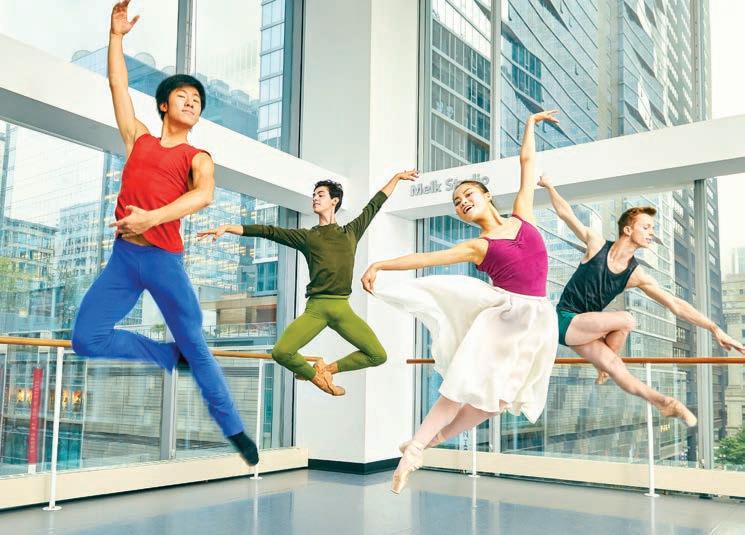
Joffrey Ballet introduces a quartet of new company members.
By OLIVER SAVA
Adecade ago, Jo rey Ballet made a major investment in its future with the Academy of Dance, an official school and training program that feeds the company with new talent while providing open dance classes to the larger Chicago community.
“It’s really rewarding that over a third of the company today has come through the academy,” says Ashley Wheater, Jo rey Ballet artistic director. That includes three of the four new dancers the Jo rey added this year: José Pablo Castro Cuevas, 18; Jonathan Dole, 21; and Miu Tanaka, 21. Hyuma Kiyosawa, 18, also joins the company, earning an invitation after impressing Wheater at the 2018 USA XI International Ballet Competition last year. When choosing candidates to promote from the academy, Wheater looks for a natural quality. “You want to see that they are strong technically, and have a natural sense of musicality. They have to have the ability to dance a huge repertoire. Anything from the very classical ballets like Swan Lake and Sleeping Beauty
to as far afield as Alexander Ekman or Andrea Walker.”
The first challenge for these new company members: Cathy Marston’s Jane Eyre, a Chicago premiere that fuses classical and modern ballet techniques to mine the psychological depths of Charlotte Brontë’s novel.
“Cathy Marston’s not afraid to tackle literature,” says Wheater. “She’s a woman who enjoys the narrative, and her production of Jane Eyre spoke to me. She’s taken a great novel and crafted a really beautiful work. Her work and the way the company is bringing it to the stage, it’s a really good fit.”
JOSÉ PABLO CASTRO CUEVAS, 18
On his introduction to dance: “My dad was a soccer player, and my mom would make fun of my dad because he would bring little gi s for soccer. And my mom would be like, ‘No, what are you talking about? He’s going to be a ballet dancer.’ As a joke. But as I grew, I was always involved in artistic stuff. I told my par-
From le :
PHOTOGRAPHER: RYAN SEGEDI
ents that I wanted to dance, but I didn’t know what exactly. So we spent a whole day just trying to find what type of dance I like.”
On why he loves ballet: “The movement and the music, those two together are very freeing. It’s something where I wake up every morning and I’m like, ‘Oh, I get to do ballet again.’”
On overcoming boy dancer stigma: “I started dancing when I was six years old, and I had to hide it from all my friends. Once they found out, it was crazy. People stopped talking to me and were making fun of me. The director of my school talked to them and they understood what it meant to be a ballet dancer. They also included me in the jazz group of my school, and then everyone saw that I could actually dance and thought I was so cool.”
On his introduction to dance: “I started ballet when I was six years old. My father was a professional weightli er in Germany. My dad wanted me to be an athlete—weightlifting, rugby, soccer player, baseball. I had a flexible body, so he put me into ballet. On the day he told me I’m going to take ballet class, I thought it was volleyball class. They sound the exact same in our accent. I went there, put on tights, and was like, ‘What am I doing here?’”
On when he knew he wanted to be a professional: “I went to Kiev State Ballet School. I was nine years old and I went into the J
continued from 15
dorm and I saw the students so serious about ballet. Almost the same age as me, and they were so passionate. That was when I realized I had a future as a ballet dancer.”
On his main strengths as a dancer: “My mentor, Nikolai Kabaniaev, he told me a er a performance, ‘You look like fireworks on stage.’”
On joining Joffrey Ballet: “This is a place I can learn everything. I can become a better artist, a better dancer, and work with ballet masters. Classes every day, rehearsals every day, getting inspired every day.”

MIU TANAKA,
On her introduction to dance: “I started dancing when I was four years old. In Japan, it was very strict. I had no off days. Christmas, New Year’s, doesn’t matter. It was very strict, but I had good teachers.”
On what inspires her: “I know how special it is to be able to change the audience’s emotion through my dancing. It’s really difficult to make the audience love. If it’s good, I can really feel the audience’s excitement. If it’s not as good, that’s the moment when I get motivation and energy. It makes me want to get better and make the audience feel that.”
On character roles: “I love the chance to dig deep and find the character. You have different people playing the same character, and it’s the exact same steps, the same choreography, but it looks completely different.”
On her big break: “In [last season’s] Swan Lake, someone got injured and I had to jump into her spot, which I had never done before. [Academy dancers sometimes dance in mainstage productions before joining the company.] I had almost four hours to learn the performance. I watched the video. I made it, no mistakes. Because I learned all that stuff in school before, it helped me. And it showed them what I could do.”
JONATHAN DOLE, 21
On his introduction to dance: “My mom put me in a bunch of sports and I hated them all. She sent me to a dance studio in my neighborhood. ‘Go take this tap class, get rid of your energy.’”
On joining the academy: “When I first came here, we danced from 9 AM to 4:30 PM. Before I was dancing at night for two hours. Every year was challenging. The rep was really good. I wasn’t technically a ballet dancer until I got trained here as a ballet dancer.”
On starting ballet late: “Not starting in ballet made me a lot more well-rounded. A lot of people, when you start ballet, you do ballet until you retire. We’re actually doing a tap piece this year—‘The Times Are Racing’ has a tap part—so it’s an amazing opportunity to get to do that as a first year and as a soloist part.”
On ballet as sport: “Ballet has taught me so much discipline, and it gave me a place to put all of my focus. With a lot of sports, it feels like you do whatever. I definitely view ballet more as an art form, personally, but one that is very athletic.” v
CERQUA RIVERA DANCE
THEATRE 20TH ANNIVERSARY
Various dates and locations: see cerquarivera.org

Cerqua Rivera Dance Theatre turns 20 with two programs of work exploring American identity.
By IRENE HSIAO
Cerqua Rivera Dance Theatre, founded by composer Joe Cerqua, choreographer Wilfredo Rivera, and the late visual artist Matt Lamb, celebrates its 20th anniversary with two programs of new works devoted to American identity, including works by choreographers Shannon Alvis and Monique Haley that explore Native American and African American heritage, as well as the premiere of Rivera’s evening-length work devoted to the immigrant experience, American Catracho. Drawing from his own story and those of his loved ones, Rivera says, “I wanted to share the traumatic components of migrating from another country and the story of working men and women who are looking for a new hope, a new land, a new opportunity.”
Born in Honduras, Rivera arrived in the United States at the age of 12. “My parents are musicians,” he says. “They saw something artistic in me that we don’t have the opportunity to explore and to relish in my country. They wanted to take me to a place where I could study this art form.”
Rivera graduated valedictorian from the New Orleans Center for the Creative Arts, a
tuition-free arts conservatory that counts Wynton and Branford Marsalis and Harry Connick Jr. among its alumni. Though offered scholarships to college, Rivera could not attend. “There were many things out of reach because I did not have a green card,” he says. “A lot of my professional choices were made because of what I could do with the resources I had, which was my talent. I auditioned for Gus Giordano and Hubbard Street, and I was lucky enough to receive apprenticeships with both of them.” At Hubbard Street, Rivera met choreographer Sherry Zunker, who hired him as a founding member of River North Dance Company, where he danced for several years. Yet as he began to choreograph for musical theater in the city, Rivera realized he wanted to found his own company.
“Since I grew up with musicians, live music was the missing element. That was the initiation for starting Cerqua Rivera. Once you put live bodies behind those notes, it’s going to feel di erent all the time. Coming from a jazz and Latin background, the e ervescent and joyful and spontaneous reaction and counterreaction is inspiring, thrilling,” he says. The company would also prove to be Rivera’s claim to permanent residency. “I became legal because of my work in the community and my company. I was creating work, presenting it, and employing musicians, dancers, and composers. I was teaching for schools as well, bringing dance and arts to [areas of] need. I was able to present all of this as my immigration case.”
“I feel American,” says Rivera. “This is where my life is, this is where I have invested so much energy and talent and artistic language and work.” v
@IreneCHsiao
King Hedley II at Court brings Old Testament fury to Pittsburgh.
By SHERI FLANDERS
In his epic masterpiece King Hedley II, the penultimate play in his Century Cycle, August Wilson captures man, society, and God in a bottle, and director Ron OJ Parson uncorks its glory and unleashes its fury on the Court Theatre audience like a torrential downpour. As the play opens with thunder and an ominous, prophetic Shakespeare-esque prologue, we meet Dexter Zollicoffer’s Stool Pigeon, the friendly neighborhood hoarder who in a different era might be called “touched”—a euphemism for one who can commune with a higher plane, and who also presents symp-

toms of mental illness. Zollico er inhabits the role with hilarious gusto and sobering dread, reminding us frequently that “God is a bad muthafucka.”
Assemble and Duval Timothy in collaboration with Demond Melancon and the Material Institute, New Orleans

RKING HEDLEY II
Through 10/ 13 : Wed-Fri 7: 30 PM, Sat-Sun 2 and 7: 30 PM, 773 -753 - 4472 , courttheatre.org, $ 50 -$ 84
It’s 1985, and Reagan’s “trickle-down” economics have left the soil dry and parched. There are few jobs, which makes other methods of earning seductively compelling—if not essential to survival. In a society that yokes the output of an individual to self-worth, what is the measure of a man without work? Must securing his humanity require blood sacrifice?
Kelvin Roston Jr. is outstanding as Hedley, a man of modest lineage who stands fast in the eye of a great and terrible storm. His brow bears the substantial weight of Wilson’s storytelling, a too-young man reckoning with racism, family legacy, betrayal, and the vengeance of an Old Testament-wrathful God who does not su er fools gladly. When Hedley asks, “Do I have a halo over my head?” it’s a desperate plea for salvation from the merciless hand of fate before the scythe cuts him down.
Director Parson deftly navigates the relentless waves of grief that bu et Hedley’s kingdom by o ering frequent comedic beats, leaving the audience unmoored and vulnerable for the next sucker punch. One of the standout
emotional moments is a showstopper monologue delivered by Kierra Bunch, who plays Hedley’s girlfriend Tonya, where she reckons with the nature of foresight, love, mercy, and a subject that still remains taboo.
Both female characters are rich and layered, and Ruby (TayLar), Hedley’s mother, is no exception. A shrewd, uncompromising woman, Ruby knows that regret is just as much a part of life as joy. She and her beau, Elmore, played by the indomitable A.C. Smith, have great chemistry, and as TayLar and Smith tease out subtleties in the complex tale of their relationship, they treat us to a Rashomon -like retelling of history as a parable and maybe even a glimpse of destiny.
Rounding out the cast is Hedley’s best friend, Mister, played by Ronald L. Conner. He brings levity and an impish charm to scenes of sobering shenanigans that remind us that these men are still children, grasping for the trappings of adulthood like blind seedlings pushing up instinctively through the soil. v



THE KING’S SPEECH
Through 10/20 : Wed 1 and 7: 30 PM, Thu-Fri 7: 30 PM, Sat 3 and 8 PM, Sun 2 PM; also Tue 10/1, 7: 30 PM; Thu 10/ 17, 1 PM; and Sun 10/ 13, 6: 30 PM, Chicago Shakespeare Theater, 800 E. Grand, 312- 595 - 5600, chicagoshakes.com, $ 50 -$90

The King’s Speech
Bernhardt/Hamlet examines the sexual politics of Shakespeare through the eyes of a famous actress.
Back in 2007, New Yorker theater critic John Lahr dismissed Theresa Rebeck’s play Mauritius, about a woman getting involved with petty thieves, as “Mamet for girls.” I remembered that while watching Rebeck’s 2018 Broadway comedy, Bernhardt/Hamlet, now in its local premiere under Donna Feore’s direction at the Goodman—and not just because a sexist critic plays a supporting role and decries an actress’s ambition with “You are a freak.”
The King’s Speech looks good, but the drama is inert at Chicago Shakes.
By CATEY SULLIVAN
The rise of Albert, Duke of York, from stammering puddle of self-doubt to global champion in the fight against Nazis is a story with all the right stu . There’s a scandalous royal romance, a world on the precipice of disaster, and in “Bertie,” an underdog who’s easy enough to root for. In director Michael Wilson’s staging of David Seidler’s drama for Chicago Shakespeare Theater there are also Downton Abbey -worthy period costumes by David C. Woolard and a cast led by Harry Hadden-Paton (Downton’s Seventh Marquess of Hexham, aka Lady Edith’s husband). Opening the play the same weekend as the Downton movie was a savvy move: Hadden-Paton comes with a built-in publicity bonanza.
But the production is more a series of eye-catching historical tableaux than a living, breathing drama. Seidler’s dialogue is occasionally clever, particularly when speech therapist Lionel Logue (James Frain) is at his most insouciant. But pretty pictures can’t carry a drama. And that’s what The King’s Speech o ers: artfully blocked actors looking fabulous. If you’re seeking illustrations for a thoroughly Anglo-Saxon-centric history text, look no further.
Seidler wrote the play before he wrote the screenplay of the Oscar-winning 2010 movie of the same name. Unlike the movie, the action here is restricted to interiors. The primary sig-
nifier of a change in locale in Kevin Depinet’s massively walled set is indicated by lighting fixtures that go up and down as the action moves about—it feels like they’re getting more of a workout than the cast. Projection designer Hana Kim does most of the heavy lifting; Depinet’s walls serve as screens that morph into variously sumptuous wall coverings and teeming masses of Brits.
The first act hangs on the crisis that arises when Bertie’s elder brother, David (Jeff Parker), insists on marrying Wallis Simpson (Tiffany Scott), presenting the unthinkable possibility of an American divorcee becoming Queen of England. That’s settled offstage, during intermission. David abdicates in the second act, having had a complete change of heart while the audience was in the loo.
Hadden-Paton makes Albert easy to sympathize with—as much as he can. Albert’s insecurities aren’t uncommon, but like most problems, they’re far easier to deal with if one doesn’t also have to worry about things like money or housing and has hundreds of sta on call to do one’s bidding 24/7. And despite the looming menace of a global war, The King’s Speech is strikingly insular. There isn’t a person of color to be found in this version of England, only a brief mention of colonial Africa and New Zealand.
Anglophiles are apt to love the production, especially those starving for the next season of The Crown . Chicago theaterphiles should know this: John Judd is killed o early and relegated to an o stage speaking role thereafter. That’s enough to make you want to petition the king, or better yet, the casting director. v
@CateySullivan
Though Rebeck has written many essays on sexual discrimination in theater, she’s now put those thoughts in a play about theater. Set in Paris in the late 1890s, the story revolves around Sarah Bernhardt (Terri McMahon), the glorious (but aging) doyenne of the stage who, having outgrown ingenue roles, decides to play Hamlet. Only this woman of both sexual allure and seemingly indomitable self-assurance can’t work her mind around the indecisiveness of the Danish prince, so she enlists her lover, pre-Cyrano de Bergerac Edmond Rostand (John Tu s), to rewrite it for her own strengths. “A woman who cannot do anything is nothing. A man who does nothing is Hamlet” she points out—an acidic reminder that women are o en judged on resumés and men praised for “potential.”
Rebeck’s play, at least in this production, tends to work better taken in parts, but those good parts are pretty glorious. A scene between McMahon’s Hamlet and Larry Yando’s Ghost is as transcendent as the brilliant moment in the TV series Slings & Arrows where a director dissects the psychology of Ophelia. At nearly three hours, Rebeck takes a little too long to make her points, but it’s overall a delightful and thought-provoking theatrical exercise. —KERRY REID BERNHARDT/ HAMLET Through 10/20: Wed 7:30 PM, Thu 2 and 7:30 PM, Fri 8 PM, Sat 2 and 8 PM, Sun 2 PM; also Sun 9/29 and Tue 10/15, 7:30 PM; Thu 10/10, 7:30 PM only, Goodman Theatre, 170 N. Dearborn, 312443-3800, goodmantheatre.org, $25-$80.
Open Door Repertory’s The Best of Enemies makes the case for finding common ground in troubled times.
Some plays seem tailor-made for small spaces. Such is the case with Mark St. Germain’s powerful fourhander, adapted from Osha Gray Davidson’s 1996 book The Best of Enemies: Race and Redemption in the New South (also the source for a 2019 film), about the real but unlikely friendship that developed between Ann Atwater, a fiery civil rights activist, and C.P. Ellis, an equally fiery “exalted cyclops” of the Knights of the Klu Klux Klan, in Durham, North Carolina, in the early 1970s. As performed in Open Door’s intimate 75-seat house, this show is riveting. Even the quieter moments of the play raise the roof, as when a er lots of shouting and finger jabbing and name calling, these two stubborn souls suddenly discover they are a er the same things—a good education and a better future for their children.
In Ellis’s words, “The amazing thing about it, her and I, up to that point, [had] cussed each other, bawled each other, we hated each other. Up to that point, we didn’t know each other. We didn’t know we
had things in common.”
It helps, of course, that the show, under the direction of Sonita L. Surratt and Mary Pat Sieck, unfolds so gracefully. They know how to use the small stage to full advantage, as do the show’s stars, Felisha McNeal and Brendan Murphy. McNeal and Murphy have strong enough lungs to bellow with the best of them. But they’re equally adept at speaking so ly enough that we lean forward to hear every word. Maybe if enough people lean forward, they will listen. In a time of division, the story of Atwater and Ellis gives one hope. —JACK HELBIG THE BEST OF ENEMIES Through 10/27: Fri-Sat 8 PM, Sun 3 PM, Open Door Repertory Company, 902 S. Ridgeland Ave., Oak Park, 708-386-5510, opendoortheater.net, $27, $25 seniors, $15 students.
Lili-Anne Brown’s production for Drury Lane stirs the soul.
There is no doubt the 2005 musical adaptation of Alice Walker’s 1982 Pulitzer Prize- and National Book Award-winning novel (which also draws on Steven Spielberg’s blockbuster 1985 movie) has a wonderful score, packed wall-to-wall with powerful, soul-stirring music and clever lyrics by Brenda Russell, Allee Willis, and Stephen Bray—all seasoned veterans of the music industry when they began collaborating on this show. The original cast album for the 2015 Broadway revival even won a Grammy.
Director Lili-Anne Brown, her choreographer, Breon Arzell, and her strong cast of triple threats take full advantage of the superb score. Much of the inner life of the main character, Celie, and her journey from shy, abused daughter of a sharecropper to a happy, assertive clothes designer we learn through the show’s songs and dances. And that is plenty, though it also helps that Celie is played by Eben K. Logan, an actor with enough power and grace to play a character who’s the very personification of the expression “still waters run deep.”
The score for this show is so successful it almost doesn’t need a book. Good thing, because it almost doesn’t have one. Marsha Norman does the bare minimum with Walker’s story to keep it going—she sets scenes, introduces characters, and then gets out of the way. But with a production as thoroughly entertaining as this one, that is just an observation, not a criticism. —JACK HELBIG THE COLOR PURPLE
Through 11/3: Wed 1:30 PM, Thu 1:30 and 8 PM, Fri 8 PM, Sat 3 and 8 PM, Sun 2 and 6 PM, Drury Lane Theatre, 100 Drury Lane, Oakbrook Terrace, 630-530-0111, $55-$70.
Rebecca Alemán examines the personal price paid by human rights journalists.
According to a recent NPR story, 12 journalists have been murdered in Mexico so far this year, making it the deadliest nation in the world for reporters. Rebecca Alemán’s two-character play for Water People Theater (presented as part of the third annual Chicago International Latino Theater Festival: Destinos) addresses the crisis through the story of Paulina (played by Alemán), a Venezuelan-born human rights reporter in Mexico trying to regain her memory and speech a er being in a coma for several months.

Paulina’s caregiver is her former coworker, Rodrigo (Ramón Camín), whose sympathetic demeanor seems to mask a darker secret that comes out gradually over the 90 minutes of the play. But The Delicate Tears of the Waning Moon isn’t a whodunit so much as a “why do it?” Why do journalists like Paulina risk so much, and does their sacrifice make a difference? Sobering questions, to be sure. But Alemán, as both playwright and actor, imbues Paulina with a defiant wit that animates her fragile physical exterior and lets us see precisely what kept her going as she reported on violence waged against other women, especially Indigenous activists.
Director Iraida Tapias skillfully underscores the
play’s many moments of tenderness and poetry (Rodrigo reads Octavio Paz aloud), even as Paulina begins to piece together what happened to put her in the coma. The reason she and so many real-life women journalists have been targeted? “For telling the truth. For doing their job. Because they’re women.” As the play honors the memory of journalists like Miroslava Breach, it also asks us to be brave enough to look at the same injustices they wrote about. —KERRY REID THE DELICATE TEARS
OF THE WANING MOON Through 10/13: Thu-Sat 8 PM, Sun 3:30 PM, Steppenwolf 1700 Theatre, 1700 N. Halsted, 312-335-1650, steppenwolf.org, $25, $20 seniors, $15 students.
Equivocation gets tangled up in Shakespearean intrigue.
The setup to Bill Cain’s revisionist Shakespearean fairy tale is the sort of juicy, rebellious, intrigue-filled “what if” fantasy that would make Quentin Tarantino proud: What if a villainous Lord Robert Cecil (Michael Dalberg) approached the Bard (Brendan Hutt) and his company to create a propaganda play that whitewashes the recently foiled Gunpowder Plot to bomb Parliament? And what if the King’s Men deviated from their forcibly “requested” commission to instead expose a conspiracy led by a corrupt king?
Interesting premise, right? And at times over the course of this nearly three-hour Idle Muse production, it does yield some lightly comedic, o en insightful scene work from Evan Jackson’s capable and sharp ensemble. But Cain’s long-winded, hard-reference-winking, dramaturgically leaden script and writing style will likely only appeal to the most committed Shakespeare-festival nerds.
Hell, even those audiences—ones with deep-cut Elizabethan prerequisites satisfied—may have a hard time tracking the emotional beats in the plot here, which quickly and exponentially expand from the promising and focused starting point to include Shakespeare’s strained relationship with his daughter Judith (Kali Skatchke), the suppression of Catholics during the reign of James I, a fictionalized origin story of Macbeth, and the joys and pains of the creative process writ large.
By the second act, it all starts to feel more like an educational exercise than a work of theater, but de comedic performances help keep it moving, particularly Kade Cox as a decadent, unpredictable, nefarious King James I. —DAN JAKES EQUIVOCATION Through 10/10: Thu-Sat 8 PM, Sun 3 PM; also Wed 10/9, 8 PM, Edge Theatre Off Broadway, 1133 W. Catalpa, 773-340-9438, idlemuse.org, $10-$20.
RHere you come again
Hello Again offers a daisy chain of lusty interludes.
Ten pairs of lovers, ten pairs of strangers. This musical is a La Ronde adaptation, meaning it performs the same cyclical game as Arthur Schnitzler’s 1897 play about ten interlocking sets of romantic partners: the whore tosses a freebie to the soldier, who trifles with the nurse, who seduces the college boy, who leads the businessman’s young wife astray, on down the line until the whore returns and the circle is complete.
Nobody exactly frolics on this model of romance. Playwright and composer Michael John LaChiusa’s people try hard to feel the excitement of tossing away inhibition, but inhibition and dignity are so similar that they regret their transgressions immediately and wish time could go backward. Passions flag, the wrong thing is said. Suddenly, they’re not heroes in their own romances; they’re just people in rooms, misbehaving. Having tried to enliven existence by stepping out of bounds, they find that the lines have relocated

By Lauren Yee
Directed by Jesca Prudencio
“The play’s relevance could not be more immediate”
– Chicago Sun-Times
“One of the finest productions to be staged by Steppenwolf Theatre in recent years” – WTTW

to include this deviance, and the excitement of supposed transgression wears off all too quickly. As scene a er scene painfully evinces, having the thing we wanted can suddenly make us not want it anymore.
I was impressed with the fluid staging of director Brenda Didier’s production, which kicks off Theo Ubique’s new season in the company’s delightful Evanston space. I started to name actors and actresses who deserved special commendation and found there were too many; this is a stellar cast. Big up to the versatile house band, which is conducted by keyboardist Jeremy Ramey. —MAX MALLER HELLO AGAIN Through 11/3: Thu-Sat 7:30 PM, Sun 7 PM, Theo Ubique Cabaret Theatre, 721 Howard St., Evanston, 773-347-1109, theo-u.com, $34-$59, optional dinner $29.
Mother of the Maid views Joan of Arc through her mother’s eyes, but doesn’t commit to the real drama.
Jane Anderson’s 2018 play retells the o -dramatized life of Joan of Arc from the point of view of her mother, Isabelle. But though Kate Fry brings flashes of faith, fear, and ferocity to Isabelle, the story itself falls curiously flat, and not just because we know the ending.
Anderson’s use of contemporary vernacular seems designed to conjure the earthiness of Joan’s farming family, which includes choleric father Jacques (Kareem Bandealy) and bratty brother Pierre (Casey Morris). But it feels instead like a playwright making a strained case for the relevance of Joan’s story in our time—when it doesn’t feel like Isabelle is playing Edith Bunker to Jacques’s Archie. Expositional bookending monologues, delivered by Fry’s Isabelle and referring to herself in the third person, distance rather than illuminate.
The question of whether or not Isabelle fully believes Grace Smith’s Joan is having holy visions (and whether her support for her headstrong daughter is rooted at least partly in her own desire for reflected glory) is well worth exploring. But Fry’s Isabelle doesn’t make the shi s in Isabelle’s own feelings about her daughter’s growing fame feel wholly motivated.
That’s not really Fry’s fault or that of director BJ Jones. Rather, it’s the fault of a playwright who picks up lots of tantalizing shiny objects (the perfidy of the clergy, the self-aggrandizement of teenagers) and puts them down before fully exploring what they mean in the context of Isabelle’s relationship to Joan.
Fry and Smith have a scene of great tenderness and sorrow before Joan’s death that suggests the emotional depths Anderson could have reached if she’d spent more time really investing in the mother-daughter connection, rather than using it as a clothesline for airing out a story that’s been told many times before. —KERRY REID MOTHER OF THE MAID Through 10/20: Wed 1 and 7:30 PM, Thu 7:30 PM, Fri 8 PM, Sat 2:30 and 8 PM, Sun 2:30 PM; also Sun 10/13, 7 PM; Wed 10/9, 7:30 PM only, Northlight Theatre, North Shore Center for the Performing Arts, 9501 Skokie Blvd., Skokie, 847-673-6300, northlight.org, $30-$89, $15 students (subject to availability).
Oslo illuminates the behind-the-scenes machinations of Middle East diplomacy.
If A Walk in the Woods, Lee Blessing’s 1988 play about the private talks between two diplomats—one Soviet, the other American—got cozy with Noël Coward’s coun-
try-home comedy Hay Fever, the result would be similar to J.T. Rogers’s 2017 Tony-winning play. Set in 1993, Oslo traces the back-channel negotiations between Yitzhak Rabin’s Israeli government and the PLO instigated by a Norwegian diplomat, Mona Juul (Bri Sudia), and her think-tank-director husband, Terje Rød-Larsen (Scott Parkinson).
The latter in particular is a firm believer that getting the involved parties out of the official conference rooms and into more informal settings where they can see each other as individuals is crucial to achieving a breakthrough. That translates here into a series of complicated (and o en hilarious) attempts to get the PLO and Rabin’s team to meet regularly in a Norwegian country home, where they bicker over verbiage, air ancient (yet legitimate) grievances, find common ground over booze (and waffles prepared by Juliet Hart’s hostess), and—yes—take a walk in the woods.
The great strength of Nick Bowling’s smart production for TimeLine (presented in association with Broadway in Chicago) is not just how it keeps the sometimes-complicated narrative clear, though that’s no small feat. It’s how, by showing us the full range of emotions felt by these complex individuals, all of whom are invested in their people’s survival as well as their own desire for a bit of history making, we see the wisdom of Terje’s approach. There’s not a weak link in the 13-member cast. The saddest part is realizing how quickly the advances of the Oslo accords receded following fresh outbreaks of violence. —KERRY REID OSLO Through 10/20: Wed 2 and 7:30 PM, Thu-Fri 7:30 PM, Sat 2 and 8 PM, Sun 2 PM; also Sun 10/29, 7:30 PM; Wed 9/25, 7:30 PM only, Broadway Playhouse, 175 E. Chestnut, 800775-2000, broadwayinchicago.com, $35-$95.
Hannah Ii-Epstein’s Pakalolo Sweet has a communal feeling, but the story loses focus.
Staged in the coach house of a Chicago Park District facility on the shore of Lake Michigan in the Edgewater neighborhood, Hannah li-Epstein’s comedy-drama about a family of Hawaiian marijuana growers labors mightily to be an investigation of mental illness masquerading as a mellow good time. Whether one buys what she’s selling depends a lot on one’s attitude toward weed and the lifestyle connected to it.
Before the actual play begins, the audience is asked to participate in a karaoke session with the cast. Perhaps, with a group of stoned friends, this might be a good time and a fine way to set the mood, but if one expects to be presented with theater rather than a team-building exercise, this is a tedious bit of throat clearing. The hour or so devoted to the narrative feels fragmentary, though it does contain a couple of powerful moments.
The semilegal pursuit of growing pot, with its structural flaw of employees abusing the product, is convincingly evoked. But the oblique references to mental illness aren’t developed fully enough to warrant the play’s jarringly abrupt conclusion. This piece is the second part of a trilogy but doesn’t feel complete enough to stand on its own. I wished a erward that li-Epstein had canned the karaoke party and used that half hour to answer the many questions posed by what could one day be a compelling piece of theater. —DMITRY SAMAROV PAKALOLO SWEET Through 10/5: Wed-Fri 7:30 PM, Sat 4:30 and 7:30 PM, Mon-Tue 7:30 PM, Berger Park Cultural Center Coach House, 6205 N. Sheridan, nothingwithoutacompany.org, $30. v
THE MOUNTAIN ss
Directed by Rick Alverson. In English and subtitled French. 109 min. Fri 9/27-Thu 10/3. Gene Siskel Film Center, 164 N. State, 312- 846 -2800, siskelfilmcenter.org, $12

Rick Alverson’s The Mountain is a fascinating but ultimately frustrating mood piece.
By BEN SACHS
In one of my first weeks of high school, my freshman English teacher provided our class with a short passage to introduce a discussion of literary tone. The passage was a straightforward description of a walk through a public park, with details of trees, benches, and such. Then, in the penultimate sentence, the narrator mentioned seeing two men stabbing a third man to death; the passage concluded with another bland line in keeping with the earlier sentences. You can probably guess what my teacher wanted to achieve with his lesson: that a consistent tone in literature can normalize or else dampen the impact of content that might otherwise seem egregiously out of place, in this case a violent act. I’ve thought of this lesson often over the years, most recently when watching The Mountain, the latest feature by American independent Rick Alverson (The Comedy, Entertainment). The film exudes an eerily, consistently placid tone and trades in the subject of
violent subjugation. It’s ultimately a frustrating experience, though its central rhetorical device certainly makes an impression.
The Mountain takes place sometime in the 1950s in an unidentified part of the U.S. that’s woodsy and underpopulated. Andy (Tye Sheridan) is a withdrawn man in his early 20s who lives with his father (Udo Kier), a former figure skater who now owns an ice rink. Andy assists his father by tending the ice; a memorable early image presents the young man driving a Zamboni across the empty rink, his eyes fixated on something outside the frame. Alverson barely shows the two men speaking to each other, and when he does their conversation seems fraught with subtle tension. Andy’s father dies ten minutes into the film, and the older man’s death makes little discernible impact on his son, whose demeanor remains quiet and a ectless. Alverson invites us to share in Andy’s emotional state through the film’s style. The camera rarely moves, and when it does, it proceeds steadily along straight paths; the sound design is hushed and meditative, and the vivid sets and costumes evoke a cozy sense of the past that one can burrow into at the expense of the narrative content. Alverson will maintain this style throughout the film regardless of what happens. If you get on its wavelength, you may find it trancelike.
The film experiences a jolt with the introduction of Dr. Wallace Fiennes (Jeff Goldblum), who turns up at Andy’s family estate sale following the father’s death. Confident
ssss EXCELLENT sss GOOD ss AVERAGE s POOR • WORTHLESS
and talkative, Wallace seems like no one else in the movie thus far, and his presence signals a shift in the story. Wallace tells Andy he once treated the young man’s mother (it’s the first reference to her in the movie), and after a short conversation in which he does most of the talking, invites Andy out to dinner. Over Chinese food, Wallace tells Andy that he needs an assistant cum photographer to join him on his travels and asks Andy if he’d like to come along. Alverson doesn’t even show





Andy deliberating over the invitation—the next scene shows the two men on the road. It’s a clever way of illustrating Andy’s passivity, and it grants a sense of inevitability to the characters’ journey. Like the heroes of a fairy tale, Andy and Wallace seem destined to go out exploring; if Alverson’s tone weren’t so unchanging, the narrative development might inspire excitement.
Yet the director achieves something more jarring after first lulling viewers into a dreamy complacency: he shocks us with the revelation that Wallace is a traveling therapist who performs lobotomies at mental institutions
Filmmaker appearances, events & more!
ABBAS KIAROSTAMI RETROSPECTIVE
Through Oct. 30 + Ahmad Kiarostami Oct. 26
LECTURE SERIES VIEWING POSITIONS Tuesdays through Dec. 10
CONVERSATIONS AT THE EDGE Thursdays through Nov. 21
MILES DAVIS: BIRTH OF THE COOL Oct. 4 - 17
ONE CHILD NATION Oct. 4 – 10
FLEABAG Oct. 5, 12, 20, 25, 27
ELEVATOR TO THE GALLOWS Oct. 5, 9, 12
THE KILLERS (1946) Oct. 4, 6, 10 THE KILLERS (1964) Oct. 4, 6, 7
THE WOMAN WHO LOVES GIRAFFES Oct. 11 – 17
From Senegal HYENAS Oct. 11, 17
THE TIGER OF ESCHNAPUR Oct. 11, 13, 14
THE INDIAN TOMB Oct. 11, 13, 16
LUCREZIA BORGIA Oct. 12
FANTASTIC FUNGI Oct. 18 – 24
DESOLATION CENTER Oct. 18 – 24 + Jim Sikora’s MY CHAR-BROILED BURGER WITH BREWER Oct. 20
END OF THE CENTURY Oct. 18 -24
THAT PÄRT FEELING: THE UNIVERSE OF ARVO PÄRT Oct. 18, 20
IN THE MOUTH OF THE WOLF Oct. 19
THE GOLDEN GLOVE Oct. 25 – 30
GOOD KISSER Oct. 25 – 31
TONI MORRISON: THE PIECES I AM Oct. 25 – 31
CAT PEOPLE Oct. 25, 31
www.siskelfilmcenter.org
$12 General | $7 Students | $6 Members


@filmcenter@siskelfilmcenter


A series of political engagement events by the Chicago Reader
continued from 21
Get showtimes and see reviews of everything playing this week at chicagoreader.com/movies
lace’s odyssey, accepting the events of the narrative without thinking about what they might mean—but you’ll probably be disappointed if you expect the various ideas to add up to more than the sum of their parts. v
THURSDAY, OCT. 10 5:30 PM FREE!
Human Rights Campaign and CNN LGBTQ Town Hall


3349 N. Halsted 21+ / ID required / Cash bar

Hosted by Reader’s Ben Joravsky and Maya Dukmasova With special political guests from the LGBTQ community
Doors open 5 p.m. Program 5:30-6:30 p.m.
Then join us to watch on CNN:
6:30: Sen. Cory Booker
7: Former Vice President Joe Biden
7:30: Sen. Kamala Harris
8: Sen. Elizabeth Warren
8:30: Mayor Pete Buttigieg
9: Former Rep. Beto O’Rourke
9:30: Sen. Amy Klobuchar
10: Former HUD Secretary Julián Castro
Citing scheduling conflicts, Vermont Sen. Bernie Sanders and businessman Andrew Yang declined HRC’s invite.


across the country. Throughout The Mountain Alverson presents the procedure in graphic detail, and the cruelty of this outmoded practice creates an unsettling frisson with Wallace’s friendly attitude whenever he’s not in a hospital. (Goldblum’s charismatic performance, a standout in the actor’s career, is so good that it puts one at ease even more effectively than Alverson’s calming style.) Andy appears as unfazed by assisting a lobotomist as he did by his father’s death—if anything, he seems to enjoy learning the art of photography. Alverson hints that Andy is fascinated by Wallace’s work because it provides him with insight into the experience of his institutionalized mother, whom he hasn’t seen in some time; then again, the young hero seems so emotionally numb that it’s hard to say for certain what he’s thinking.
The mystery of Andy’s internal experience carries The Mountain for its first half, albeit just barely. As he demonstrated in The Comedy, Alverson has a tendency to drive his metaphors into the ground. It soon becomes clear that Andy, in his terminally subdued behavior, represents the perfect foil to Wallace in that he acts like a lobotomy patient without even needing a lobotomy, and for a good half hour or so, the film is simply a series of variations on this insight. Alverson changes things up with the introduction of two new characters: a recently released lobotomy patient named Susan (Hannah Gross) and her caretaker, Jack (Denis Lavant), the first character in the film to exhibit a genuinely explosive personality. These two join Andy and Wallace on their travels; Susan stirs a sense of sexual curiosity in Andy (perhaps for the first time in his life), while Jack spends his nights getting drunk and haranguing anyone in earshot with tirades that barely make sense. The film takes its title from one of Jack’s antic monologues, when he comments on a mass-produced painting in his motel room. “This is not a mountain!” he yells at Andy. “It is a cheap dream!”
Does Alverson mean to imply that Wallace’s therapy is another cheap dream, an illusion of serenity that’s really nothing more than forced servility? If so, he isn’t onto anything all that shocking or profound; I doubt there’s anyone who still believes lobotomies are a good idea. Maybe it’s best to take The Mountain as an extended mood piece on the themes of passivity, domination, sex, and longing, distinguished by several compelling performances and an arresting sense of tonal control. One can easily watch the film the way Andy takes part in Wal-
Cat people tend to be unfairly maligned, but in this documentary, they’re heroes. According to the filmmakers, there are as many feral and abandoned cats living on New York City’s streets as there are people in residences, and since local government has failed to handle the problem, ordinary citizens have stepped in to help. The film follows four Brooklynites who engage in TNR (trap, neuter, release) efforts, giving up space in their homes and o en spending money from their own pockets to tend to the tens of thousands of street cats that roam their borough alone. The volunteers’ collective aim is two-pronged: decrease the number of at-risk felines, and rehome as many of them as possible. But for all its good intentions, this shaggy doc elicits more heartbreak than hope; it’s difficult to watch a succession of humans surrender their cats to the Animal Care Centers of NYC, seemingly unconcerned by the knowledge their pets may be euthanized. Yet this crowd-funded portrait of urban animal activists—a labor of love itself—is commendable for spotlighting work that usually goes unseen and underacknowledged. —LEAH PICKETT 87 min. Fri 9/27, 2 and 7:30 PM; Sat 9/28, 3 and 6:15 PM; Sun 9/29, 3 PM; Mon 9/30, 6 PM; Wed 10/2, 6 PM; and Thu 10/3, 7:30 PM. Gene Siskel Film Center
Louis Garrel cowrote, directed, and stars in this piquant chamber comedy, which begins as the sort of relationship chronicle that his father, Philippe, might make, then enters into strange territory that’s reminiscent of what cowriter Jean-Claude Carrière once explored with Luis Buñuel. In the opening scene, the live-in girlfriend (Laetitia Casta) of a journalist (Garrel) tells him she’s leaving him for his best friend, who’s gotten her pregnant. The story then jumps forward a decade, a er the best friend has died of mysterious circumstances and the former couple has resumed their old relationship as though they’d never been apart. Things go well until the woman’s son confides in the journalist that he believes his mother murdered his father and the dead man’s younger sister (Lily-Rose Depp)—who’s long loved the journalist from afar—decides to steal him away from his current partner. The narrative twists come off as especially odd, thanks to Garrel’s poker-faced direction and the uniformly naturalistic performances; all the characters seem like normal people except that their behavior is unexplainable.
In French with subtitles —BEN SACHS 75 min. Fri 9/27, 2 and 6 PM; Sat 9/28, 4:45 PM; Sun 9/29, 3:15 PM; Mon 9/30, 7:45 PM; Tue 10/1, 8 PM; Wed 10/2, 8 PM; and Thu 10/3, 6 PM. Gene Siskel Film Center
Félicité
The fourth feature from Franco-Senegalese filmmaker Alain Gomis takes place in Kinshasa, capital
of the Democratic Republic of the Congo, and centers on a bar singer (Véro Tshanda Beya Mputu, luminous in her film debut) whose 14-year-old son is seriously injured in a motorbike accident. To pay for his surgery, she hits up family, friends, acquaintances, and, in desperation, a local mob boss. These tense and o en painful encounters are played without sentiment, though in the second hour their urgency gives way to detached, dreamlike sequences showing the city’s street life and to a matter-of-fact romance between the woman and her repairman. Cowritten by Gomis, Delphine Zingg, and Olivier Loustau, the meandering narrative has a lyrical quality consistent with the many musical numbers, most of which are performed by Mputu and the Kinshasa-based group Kasai Allstars. In French and Lingala with subtitles. —LEAH PICKETT 129 min. Gomis attends the screening. Fri 9/27, 7 PM. Northwestern University Block Museum of Art F
Local filmmaker Molly Hewitt makes her feature debut with this transgressive comedy about a dominatrix (played by the writer-director) who discovers she can communicate with the dead a er she huffs a magical air freshener. The narrative generally takes a back seat to Hewitt’s portrait of an inclusive underground community that welcomes transsexual men and women, sex workers, S&M enthusiasts, and all sorts of people who live to get their freak on. The generous vibe goes a long way in keeping this interesting; ditto the imaginative production design (credited to one Mood Killer, aka Columbia College grad Michael Zarowny), which pops with Day-Glo colors and an array of comically similar-looking consumer goods that suggest the influence of Alex Cox’s Repo Man. Yet Hewitt still has a ways to go in terms of storytelling; many of the scenes drag on past their welcome, and the overall pacing feels indifferent. —BEN SACHS 91 min. Hewitt and select cast and crew attend the Friday screening. Fri 9/27, 9:45 PM, and Tue 10/1, 7 PM. Music Box
Alfred Hitchcock’s 1956 film has some of the bluntness of a religious tract; it’s sort of a “Handbook on Christian Marriage.” James Stewart and Doris Day are the middle-class Americans caught up in an exotic foreign intrigue: their marriage represents an imbalance of reason and emotion, repression and expression, and secularism and faith. When their son is kidnapped, Hitchcock clearly characterizes it as an act of God meant to test their union. The film is uncharacteristically rigid and pious for Hitchcock; it feels more like a work of duty than conviction. Despite the many famous set pieces the film contains (the assassination in Algiers, the attempt at the Albert Hall), the most impressive sequence, technically and dramatically, is a quiet one in which Stewart tells Day that their child has been taken. With Bernard Miles and Brenda de Banzie. —DAVE KEHR 120 min. 35 mm. Sat 9/28-Sun 9/29, 11:30 AM. Music Box F
This charming documentary by journalist and playwright Frank Shouldice profiles Bobby Coote, an octogenarian bachelor who lives on his family’s century-and-a-half-old farm near Bailieborough in County Cavan, Ireland, with his brother Ernie; together they spend seemingly idyllic days steeped in their respective interests. In addition to being an aspiring aviator, Bobby fixes clocks, makes violins, and plays music of his own. Ernie, on the other hand, enjoys tinkering with his ham radio, fishing, and watching spaghetti westerns in the quiet

of his home. Bobby’s desire to fly leads him to buy a small plane, contract the necessary repairs for it, start taking lessons, and, finally—with the help of his family and friends—take flight. There’s not much that sets the film apart from other nonfiction portraits of eccentrics, but it’s heartwarming nonetheless. —KATHLEEN SACHS 82 min. Shouldice attends the screening. Sat 9/28, 8 PM. Gene Siskel Film Center
James and Eoin are down-on-their-luck Irish emigres living in the Bronx’s Woodlawn neighborhood. Lured by the promise of easy money, they agree to place a bet on a horse, but a er they bail on the deal, gangsters blackmail them into doing their dirty work. Joining in on their reluctant crime spree is Ruby, a generic manic-pixie-dream-girl type who at first seems to have been written for no purpose—the friends practically ignore her even a er she jumps into their getaway vehicle. But that’s the only glaring misstep in a film brimming with witty dialogue and colorful characters. Misty Button is most engaging as it explores whether these two deadbeats have any character beneath their boozy surfaces, resulting in comic and tragic twists and turns, including an uncomfortably funny church scene involving a pedophiliac ghost and experimentations with crack cocaine. —JAMIE LUDWIG 88 min. Sugrue attends the screening. Fri 9/27, 8 PM. Gene Siskel Film Center
In this light Chinese drama, a youngish journalist starts to reevaluate her life a er she’s diagnosed with ovarian cancer. Unfortunately for her, she can’t do much soulsearching because so many people are pulling on her attention: her emotionally needy mother, a money-obsessed friend, and the elderly businessman whose biography she’s agreed to ghostwrite in order to pay for her surgery. First-time writer-director Teng Congcong juggles the various interpersonal conflicts with finesse, but she rarely achieves a sense of emotional consequence despite the life-or-death crisis at the story’s center. Though the movie never feels overstuffed, too much of the drama feels canned; the mother-daughter conflict in particular recalls numerous other films and TV programs. The most successful passages tend to be those concerning the heroine’s sexual desire, which she’s afraid she’ll lose a er her surgery. Teng generates a sense of urgency from the character’s anxiety to experience sexual satisfaction before it’s too late. In
Taking place over two weekends, this festival spotlights films set in or made in the south side of Chicago, with
films and other events at multiple locations. Fri 9/27-Sun 9/29 and Fri 10/4-Sun 10/6. For a complete schedule, visit southsidefilmfest.org.
This program, part of Ism, Ism, Ism, a touring series of experimental works from Latin America, includes shorts by Pedro Chaskel and Leandro Katz and the short feature Diaglogue with Che (1968, 53 min.) by José Rodriguez Soltero, all of which consider the legacy and iconography of Che Guevara. 96 min. Thu 10/3, 7 PM. Northwestern University Block Museum of Art F
The Midwest Independent Film Festival’s annual program of short films by women directors. The event includes a reception at 6 PM and a panel discussion at 6:30 PM. Tue 10/1, 7:30 PM Landmark’s Century Centre
This festival, focused on films dealing with the political, social, and person issues related to mass incarceration, takes place at a variety of venues over ten days. Thu 10/3-Sun 10/12. For a complete schedule, visit injusticeforallff.com. v





Chicago’s beat scene has to do without the attention the city’s rappers get, but it’s a vital incubator for adventurous, ambitious instrumental hip-hop.
By LEOR GALIL
On the night of Friday, August 16, eight young men huddled over Apple laptops and samplers set up on circular tables near the DJ booth at Cafe Mustache. They were there for Open Beats, a sort of open-mike night that gives electronic producers the opportunity to play their music for an audience. The event doesn’t start till 9 PM, but the 15-minute performance slots are first come, first served, and these eight producers all wanted a chance. Chicago DJ and producer Fess Grandiose launched Open Beats in January 2016, and he’s held it on the third Friday of every month at Cafe Mustache ever since; producer Uncle El has helped Fess host it since July 2017. Each month, Fess and El select a few beat makers in advance to perform
“feature” sets, which close the night and run longer than 15 minutes. But Fess has always intended Open Beats to be a platform for aspiring producers, and its democratic promise of an outlet open to everyone remains key to its identity.
This past January, Open Beats threw a three-year anniversary party that Fess says packed Cafe Mustache. Since then, the sign-up sheet fills up earlier and earlier. “There has not been any night where there’s been any less than, like, ten artists showing up trying to play,” Fess says. “Most of those artists bring in their handful of people with them—they’re like, ‘Yeah, I’m about to play this thing.’ Two or three of those artists get there too late, and I have to turn them away.” At August’s Open Beats, the sign-up sheet maxed out almost an hour before start. “I was sure, showing up here at 8:05, nobody would be here,” Fess says.
Open Beats’ success has been a boon to a community of musicians that have otherwise had trouble marketing themselves in Chicago: the “beat scene,” as it’s rather ambiguously called, is by design very loosely defined, covering producers who make tracks in a variety of interrelated styles. Beat-scene musicians are based in hip-hop, but they incorporate groove-
based jazz as well as dance subgenres such as house and techno—and though a few might partner with rappers or singers, most prefer to approach instrumental music as complete and self-contained.
The phrase “beat scene” can also be used to describe this kind of music, rather than the people who make it, in which sense it’s used interchangeably with “live PA”—that is, a performance where a producer uses hardware (drum machines, samplers, turntables, audio e ects units) live in real time, rather than simply playing back finished tracks. Many beatscene producers insist on playing live, and some even improvise, but no one gets turned away from Open Beats for just pressing “play” on a laptop.
Chicago has had instrumental producers for decades, of course, but its beat scene coalesced in the early 2000s. From the start it’s brought together multiple generations, and it’s characterized by crossover and collaboration. Uncle El, who started rapping in the 90s as a student at Roger C. Sullivan High School, isn’t just cohost of Open Beats; he and a small collective of producers also run Push Beats, the city’s longest-running beat-scene event, now at the Whistler (its fourth venue). Kevin
Johnson, aka Mr. Echoes of production duo the Opus, began making beats in the early 90s for underground Chicago hip-hop group Rubberoom, and in June he celebrated the release of the Mr. Echoes album Needful Things at Push Beats. El’s 40th birthday celebration at August’s Open Beats doubled as a going-away party for Push Beats cofounder Marcos “Cos” Rivera, who moved to San Diego at the end of the month.
Cos was the last of Push Beats’ founders to leave Chicago. The series started out weekly in 2010 at defunct Wicker Park lounge Lokal, and it quickly became the highest-profile manifestation of Chicago’s beat scene. After two subsequent venue changes, it became monthly when it landed at the Whistler in October 2015. Push Beats may be diminished, but Chicago’s beat scene as a whole has hit a growth spurt, partly because of Open Beats. Two similar monthly showcases have cropped up in the past few months: Cutoff at Innjoy in Wicker Park in May and the Choppin’ Block at the Sil-

With sets from Jamie Hayes, Damon Locks, Shon Dervis, Mr. Jaytoo, DJ Tess, Ben Fasman, King Hippo, DJ Emmaculate, iRon, DJ Rude One, DJ Skor, Sasha Kokorokoko, Norm Rockwell, Twilite Tone, Alo, and DJ Pauly. Sun 9/29, noon, Wicker Park, 1425 N. Damen, free, all ages
PUSH BEATS
Thu 10/3, 9 PM, the Whistler, 2421 N. Milwaukee, free, 21+
OPEN BEATS
Fri 10/ 18, 9 PM, Cafe Mustache, 2313 N. Milwaukee, $ 5 suggested donation, 21+

ver Room’s Wicker Park location in June. Open Beats regular Rodolfo launched Cutoff with the help of producer Obehko, and he’s been trying to move it to the Logan Square Innjoy (as of this month he’s also changed its name to Live Beats). With producer Azarias, Obehko also cofounded the Choppin’ Block, which will need a new home after the Wicker Park Silver Room closes on October 1. The brand-new event series Kinky Yeti, kicked o by Azarias with producer Loony Is Normal and DJ Skoli, spotlights beat makers and vocalists.


These events are intimate and specialized, with small crowds that often consist mostly of other producers, but as is frequently the case in the music business, which people show up is more important than how many. Over the past few years, Chicago’s beat scene has made its presence felt far beyond the city limits. Veteran producer Ramon “Radius” Norwood,
an evangelist for Chicago music, spends most of the year living and traveling in Europe, stocking record stores with copies of releases by his ETC label. Many are his own, but most of the rest are by local beat-scene artists—on October 25, he’ll put out the Uncle El fulllength Now U C Me? Progressive jazz label International Anthem has booked beat-scene
producers for label showcases and released beat-scene music, and one of the most popular artists on its roster, jazz drummer Makaya McCraven, broke out beyond the jazz audience after Chicago beat-scene events spurred him to explore its production techniques on his own albums. He’s been positioned as a modern “savior” of jazz, much like Kamasi Washing-
ton, and attracted glowing profiles by the New York Times and Rolling Stone
Producers from the Chicago beat scene have also had successes outside it, even though the scene itself gets almost no publicity. Kenny Keys played a live PA set at Pritzker Pavilion in July as part of the Millennium Park Summer Music Series, and that same month, Marco




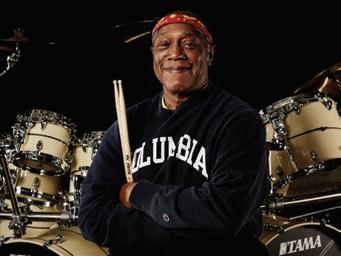



“Maker” Jacobo released the instrumental album Systematic Soul, his fourth for Los Angeles label Now-Again. Run by Egon, creative director of the J Dilla estate, Now-Again has licensed Maker’s music for TV and movies, including 2017’s The Big Sick. And Slot-A produced the majority of one of the year’s most significant albums: Jamila Woods’s Legacy! Legacy!
To begin August’s Open Beats, Fess asks for a moment of silence to honor LA producer Ras G, aka Gregory Shorter Jr., who died at age 40 on July 29. Ras considered himself a disciple of Sun Ra and made experimental instrumental hip-hop he called “ghetto sci-fi.”
In the late 2000s, Ras and other eccentric LA producers (Flying Lotus, Daedelus, Samiyam, Dibiase, Nosaj Thing) achieved mainstream popularity with the first beat scene to become widely known by that name. Their community’s center of gravity was the weekly series Low End Theory, founded in 2006 by DJ and producer Daddy Kev and discontinued in August 2018. Daddy Kev also owns Alpha Pup Records, which has released the music of several Low End regulars. Flying Lotus launched his Brainfeeder label in 2008, providing another platform for emerging artists eager to push the boundaries of instrumental hip-hop, and two years later UK label Ninja Tune began distributing Brainfeeder releases. By March 2011, when Radiohead front man Thom Yorke DJed at Low End Theory with Flying Lotus, LA’s beat scene had already had its crossover moment.
Even before then, that community was attracting heads from around the world. In the mid-2000s, beat-scene music from LA had reached DJ and events producer King Hippo, aka Chicagoland native Alejandro Ayala. He
was living in Tokyo at the time, and considered moving to LA. “There was a bunch of awesome music that was coming out of there, and it was all coming in at once,” Hippo says. “I was super interested to see what was happening over there and thought I would try my luck.”
Fortunately for Chicago’s beat scene, Hippo changed his mind—he came back here instead.
LA’s beat scene could only have achieved its influence after the rise of online networking made it easy for musicians to find fellow lovers of subversive sounds. “One of the biggest outlets that we had was MySpace, to be honest with you,” Radius says. He’d eventually play Low End Theory several times, beginning in 2009. “We were all listening to each other. I’d come home and have like 300, 400, 500 plays a day. We would be in our top eight—we’d be in Dibiase, Ras G, and Flying Lotus. We all were in each other’s vision, trading music.”
The message boards for LA label Stones Throw began hosting weekly beat battles in 2007 (if not earlier—the boards are dead, so it’s hard to be sure). Each Saturday, the previous week’s winner would post a sample for producers to use in an original instrumental to be uploaded by the following Wednesday. Forum users voted for their favorite track at the end of the week, and the cycle started over.
The Stones Throw site was a natural hub for beat makers eager to experiment with instrumental hip-hop, since the label worked with two artists who had become foundational to the beat scene: Madlib and J Dilla.
The Stones Throw beat battles were important for Chicago producer Sev Seveer in the late 2000s, when he was an undergrad at the University of Illinois at Urbana-Champaign.
“It became this community of folks all studying each other’s techniques and approaches to each sample,” he says. “I had won a couple beat battles on there—during that time was really when I started to develop my own tastes, my

own styles, and had a lot of influences as well from there.” After Stones Throw closed the boards last year, longtime posters launched stbbforever.com to keep the community going. Sev graduated in 2010 and moved back to Chicago, getting involved in The Hip-Hop Project , a mix show that’s aired on Loyola radio station WLUW since 1995 (it’s now run by DJ Scend and Slot-A). He also continued to post original material online, both as part of Stones Throw beat battles and on Soundcloud, and that’s how the local beat scene found him. In 2012 Cos heard something Sev had shared and invited him to check out Push Beats.
Cos decided to pursue music after falling three and a half stories o a balcony—there’s nothing like a brush with death to help you clarify what you want to do with your life. He enrolled at Harold Washington College to study piano in 2004. Though he grew up on hip-hop, he’d subsequently gotten
into boundary-pushing jazz by the likes of Je Parker, Ken Vandermark, and the Association for the Advancement of Creative Musicians.
“That’s what was drawing me, in my musicality, to seek becoming a better musician,” he says. In class, he met Brandon “Illiac” Murphy, who shared his tastes. “We would be in jazz class but reminiscing about hip-hop and talking about some of the current electronic music that was going around,” Cos says. Cos dropped out of college in 2005, after three semesters—he’d had a son, and was finding it hard to keep up with schoolwork. But his bond with Illiac continued to deepen, and as his friend got hooked on electronic production—first with Ableton, then with modular synthesizers—Cos learned alongside him. In 2010, Illiac got invited by his friend Adam Bowsman (aka Abyss) to host a music night with him and Raj Malosh (aka Raj Mahal) at Lokal. Abyss asked Illiac if he could recommend anyone else, and once Cos came aboard,
the four of them launched Push Tuesdays, which became Push Beats within a year.
“It was really cool that people could bring what they made in their basement or in their room or whatever, and play it out in front of people,” Raj says. Raj caught the production bug while still living in his native Detroit, after hearing producer House Shoes spin tracks by his most famous collaborator, J Dilla. He made his first beats using an MPC 2000 sampler he shared with his friend John Utsler, an original member of Insane Clown Posse and brother of Joseph Utsler (aka Shaggy 2 Dope).
The rest of the Push crew (and the scene growing up around them) shared Raj’s a nity for Dilla, but despite their aesthetic consensus they resisted giving a name to the style of music they’d incubated. “We really had a hard time describing the genre—and I still feel like I have a hard time describing it,” Raj says. “What was exciting to me—and I feel like was common amongst us—was that there wasn’t a whole lot of parameters. There was an essence that existed in it, and that was like a harder hip-hop form, but you could go anywhere around that.”
The Push producers, Raj says, decided early on that they wanted to grow beyond Chicago to establish a midwest touring circuit to bring in like-minded producers from the coasts or even abroad. That hasn’t happened yet, but Push has thrown parties bigger than its regular events. Cos remembers one during the 2012 Pitchfork Music Festival that the police broke up. “Flying Lotus was supposed to play—Jeremiah Jae was onstage, and the cops told him he better not rhyme one more lyric or they’re going to take all the equipment,” Cos says. “That was fun—400, 500 people in this warehouse across from a Department of Corrections building.” The Push crew had better luck with a loft party they threw the following December featuring Toronto’s Elaquent and LA’s Knxwledge.
The Push collective grew as the events took o —at one point it had ten members. Sev came aboard in 2013. “I sat in front of these dudes, in a multiperson interview, when I became a resident,” he says. “They were all sitting in a circle at Cos’s place, and there was almost like an initiation.”
Push survived the loss of its first three venues—Lokal, Rodan, and Double Door’s basement space, Door No. 3, have all closed— in part because the crew’s members are so tightly bonded. Raj Mahal and Uncle El, for instance, were roommates in 2011. “I would hear him working on stuff and just be like, ‘Whoa,’” El says. “It was awe-inspiring and got me to where I am now, wherever that is.”
Makaya McCraven says Raj is one of the best beat makers he’s met in Chicago.
Push Beats fosters a collegial environment, where producers are encouraged to learn from one another rather than jealously guard their secrets. “Cos is a classically trained pianist, and every one of his shows I’ve seen has a di erent feel, because he’s actually still playing keys live,” Fess says. “That within itself is what made me think, like, ‘I need to step my game up, and at least o er more than just me playing premade productions.’”
Sev bought his first Roland SP-404 sampler after becoming a Push resident. “I realize I’m most expressive when I’m using hardware,” he says. He started getting booked for more gigs after he began improvising live with Cos. “I would come with a bunch of samples, and he would come with this keyboard, and we would have absolutely no idea what we were going to do going into this set,” Sev says. “That’s when the dynamic of my performances changed—when folks could see that I knew as much about what I was gonna do as they in the audience did, and they saw that vulnerability.”
Kevin “Mr. Echoes” Johnson says he played his first instrumental hip-hop set in the early 2000s. Echoes and his collaborator in the Opus, Aaron Smith (aka the Isle of Weight), opened a show at Metro.
“We grabbed our drum machines—Aaron had his ASR-10 and his MPC, I had my MPC— and we basically got onstage and traded beats,” Echoes says. “Everything was so slow back then. It was so funny, because he’d load up a beat while I was playing, and then I would literally have to wait for him to finish loading the beat. So I had to be as creative as possible with a track that I’m doing, because I would have to wait for him.” Their MPCs used floppy disks, which didn’t have much storage space—a single song might require four or five disks.
Before that show, Echoes says, he’s not aware of any Chicago producers playing live instrumental hip-hop. There wasn’t a regular public forum for people making that kind of music till 2005, when producer Tone B. Nimble (a member of the All Natural collective and the owner of its record label) launched Dance to the Drummer’s DB at beloved Noble Square club Sonotheque. “When other people were doing beat showcases, I didn’t feel like they were highlighting the producers the way they should be highlighting them,” Tone says. “You didn’t get to see a real presentation.” Dance to the Drummer’s DB encouraged producers to bring samplers, drum machines, and synths, and to set up in the middle of the crowd. “I J



continued from 27
wanted producers to feel the energy from the audience,” says Tone.
Dance to the Drummer’s DB was the seed of Chicago’s current beat scene. The event incorporated a battle component via a March Madness-style tournament, but the competition didn’t prevent Tone from bringing together di erent beat-making collectives and creating a new community. “It became more of a unified thing,” says Marco “Maker” Jacobo. “I met a lot of producers there that I didn’t really know—it’s the first time I met Tall Black Guy—and got to play with a bunch of people.”
For Kenny Keys, the series opened new doors. In the late 90s, he’d started producing for Pugslee Atomz’s underground hip-hop crew, the Nacrobats, whose Uptown headquarters, Dover Crib, was also a recording studio. (Radius lived there briefly in 2001, learning about production techniques.) Dance to the Drummer’s DB introduced Kenny to many more of Chicago hip-hop’s heavy hitters— Molemen cofounder Panik, Twilite Tone, No ID—and challenged his approach to performing and recording. “It opened my mind, big time, to be even more uninhibited when I work, even alone,” he says.
Dance to the Drummer’s DB lasted only a couple years, but the audience it found inspired other producers to start their own nights. Push Beats wasn’t the only new series to emerge in the late 2000s and early 2010s: Maker cofounded Face Melt, Uncle El helped start Tronic, and Joshua “Lokua” Kleckner of the Moment Sound collective launched Heartbeats.
Face Melt occasionally threw events at Darkroom and Reggies’ Rock Club, and its record label had released two Kenny Keys albums by 2013. Tronic struggled to pull a crowd at its original home, Red Kiva in the West Loop. “Nobody was feeling like the bass-heavy beats music, that whole LA beat-scene vibe,” El says. “People would be like, ‘What is this?’ They were talking to the bar manager: ‘Why you letting these guys do this night? What is electronic music?’” The series did better at its subsequent locations, Sonotheque and Darkroom, but still folded a couple years later.
Heartbeats was a weekly live PA series at Morseland in Rogers Park that died when the club closed in 2012. “There were only so many people doing live PA,” Lokua says. “It wasn’t necessarily focused on hip-hop—we had people doing techno, people doing glitchy stu .” In total he booked more than 100 producers for the series, including Radius, who released some music through the label run by Lokua’s Moment Sound collective.
Heartbeats was also the event that first hooked McCraven on Chicago’s beat scene. King Hippo got involved through Push Beats after moving back from Tokyo, and the two of them met in June 2014 after Radius told Hippo to check out a McCraven show at Double Door. They’d end up working together as part of Hippo’s stateside version of a Tokyo event called Raws: a jazz combo would open the show, and then a handful of beat makers would have an hour and a half to make original tracks by sampling a recording of the combo’s set.
Hippo hosted a Raws night in Chicago in 2014 with a jazz group led by bassist Junius Paul (Radius and Raj Mahal made beats), then another in LA in 2015 with McCraven and Je Parker. Raws was too expensive to do regularly, but Hippo adapted the idea into a Whistler monthly called Fresh Roasted, which ran from 2014 till 2018: DJs would simply pick records for producers to sample.
Subsequently Hippo pitched in to book beat makers at International Anthem showcases and help produce two McCraven albums with beat-scene bents: 2015’s In the Moment Remix Tape and 2017’s Highly Rare.
McCraven’s path into the beat scene is unusual: most producers come to it from hiphop. Slot-A had his epiphany while watching Flying Lotus play the inaugural North Coast Music Festival in 2010. He picked up tips about hardware at Push Beats and learned techniques from Cos, Radius, and other elder statesmen. The December 2015 death of Timothy Jones, aka influential Chicago hip-hop DJ and radio personality Timbuck2, spurred Slot-A to consider what he could accomplish in the beat scene. “I was like, ‘If I only had a couple more years to live, what would I want to spend my time doing?’” he says. “It’d be dope to give other producers a platform. It’d also be dope to share my knowledge.” In 2016 he launched Beat Lo-fi Social, a monthly series at Subterranean with a spinoff Web radio show, and it lasted a couple years.
Beat-scene events tend to be ephemeral— even Push Beats, at almost ten years old, is no Too Much Light Makes the Baby Go Blind—but of the series active today, the one that’s doing the most to inspire newcomers and revitalize the community is Fess Grandiose’s Open Beats. Fess grew up in the south suburbs and began producing right out of high school in the late 2000s, hoping to provide tracks for his own rapping. His 2011 mixtape, Life in Lo-Fi . . . Vol. 1, features guest verses from J Dilla collaborator Guilty Simpson, but it was his last release as a rapper. Around the same time, he got his first invitation to Push Beats from Raj Mahal, who’d found Fess’s instrumentals on

Soundcloud. “Seeing what they were doing on a weekly basis, when I was like 22, 23—that was everything,” Fess says. “When I started Open Beats, I literally went up to Cos, and I’m like, ‘Are you OK with me doing this?’ Because I didn’t want them to even perceive that I was trying to compete.”
Cos doesn’t seem to have minded, given that Open Beats hosted his farewell party.
Beat-scene music isn’t generally chart material, the e orts of FlyLo and company notwithstanding—instrumental music rarely outcompetes songs with vocals in that arena. But a recent development in the streaming ecosystem could drive a flood of new fans to the beat scene’s door.
In the past couple years, a style of instrumental hip-hop called “lofi” has exploded online. YouTube channels such as College Music, Chillhop Music, and ChilledCow run 24-hour streams of beat-driven wallpaper. The biggest channels have subscriber counts in the millions, curate popular Spotify playlists, and even sell clothing. Chillhop Music, based in the Netherlands, also runs a record label.
These outlets pitch instrumental hip-hop as relaxation music or “beats to study to.” Sev Seveer likens lofi to 80s smooth jazz—and just as relatively rigorous jazz musicians must have hoped to attract some of the smoothjazz crowd, the beat scene might benefit from the huge numbers of people exposed to a watered-down version of what it does. “I’ve heard folks identify my stu as like, ‘Oh, you make homework beats,’” Sev says. “I think now
that ‘lofi chill’ or whatever—now that that’s starting to reach a much greater audience, it’s just starting to be di erent, and corny in some respects.”
Whatever effect lofi will have on the beat scene’s listeners, it doesn’t seem to have influenced its practitioners. Guatemalan-born producer Rodolfo, who runs Live Beats at Innjoy, is a relative newcomer to the scene, introduced to it at Open Beats just a couple years ago—but he came looking for psychedelic instrumental hip-hop like Flying Lotus.
Fess calls Rodolfo an Open Beats all-star: he’s only missed a few in two years, and he played a feature set in July. “Since I came here, every month I wanted to have something fresh—like a new track, a whole new set,” Rodolfo says. He’s accumulated enough material for what he hopes will be his full-length debut, which he’s tentatively titled Tools of Conquest. Other beat-scene newcomers seem to be following the same path. If this keeps up, when the millions of people listening to “homework beats” get tired of that, they’ll have a selfsustaining community of adventurous, ambitious producers to seek out. Among the openmike performers at August’s Open Beats was Hameedullah, a 24-year-old who spent part of his set rapping. He found the series through Instagram while looking for something like Low End Theory in Chicago—a place where he could find other producers eager to make their mark. “I just wanted to be a part of it,” he says. “And to see if I can take it to another level.” v
@imLeor
Recommended and notable shows and critics’ insights for the week of September 26

PICK OF THE WEEK
Mainstream pop is finally here for Lizzo
LIZZO’S SINGLE “TRUTH HURTS” dropped in September 2017, but it didn’t hit number one on Billboard’s Hot 100 chart until this month. That sleeper-hit narrative fits her: ever since her first album, 2013’s Lizzobangers , the singer and rapper has been slowly but steadily growing her following thanks to her incredible bops, celebratory music videos, and high-energy live performances, where she sometimes incorporates her first instrument, the flute. Why did it take mainstream pop so long to catch on? Today, Lizzo isn’t just topping the charts. She’s a TikTok meme, a VMAs headliner, an Absolut Vodka spokesperson, and a supporting actress in Jennifer Lopez’s new movie, Hustlers—and on top of all that, she’s become an icon of body positivity. On her latest album, this spring’s Cuz I Love You ,
Lizzo channels self-love and empowerment on upbeat songs such as “Soulmate” and “Like a Girl,” but she comes across as most powerful on the subdued, almost sinister R&B jam “Tempo” (featuring the legend Missy Elliott). “Slow songs ain’t for skinny hoes,” Lizzo drawls, carving out an explicit space for fat bodies in pop music. Though a pop icon with a fat body still feels radical in 2019, Lizzo takes the spotlight with such ease that it’s possible to imagine a future where body diversity is a given among Top 40 stars. “When all the dust has settled on the groundbreaking-ness, I’m going to still be doing this,” she told Allure magazine in her March 2019 cover story. “And if that’s body positive to you, amen. That’s feminist to you, amen. If that’s pro-Black to you, amen.” —MEGAN KIRBY
Plantasia Featuring groups drawn from a large pool of musicians: Andy Ortmann, Ben Billington, Brett Naucke, Chandeliers, Emma Hospelhorn, Jim Magas, Natalie Chami, Oui Ennui, Sam Wagster, Tony Janas, and Whitney Johnson. Rob Sevier DJs between sets, and Andrew Savage closes the night. 6 PM, Garfield Park Conservatory, 300 N. Central Park, $25. 17+
On his 1976 album Mother Earth’s Plantasia , composer Mort Garson captures some of the most inventive sounds and most radical notions of the mid-70s. Specifically, he made his goofy and endearing compositions solely on the relatively new Moog synthesizer, and he intended that they be played for plants to help them grow. Inspired by his wife’s houseplants, the work of Robert Moog, and a controversial 1973 book about plant sentience, Garson created a wholesome mix of sounds, including playful arpeggios, dainty melodies, and warm textures. Over the decades Plantasia developed a cult following, and this past summer the album (initially distributed through a modest houseplant store) was reissued for the first time by Brooklyn label Sacred Bones. To celebrate the album’s wonky-weird goodness, the label is partnering with hidden-wonders blog Atlas Obscura and Empty Bottle Presents to host an event at Garfield Park Conservatory that features Plantasia listening sessions and live interpretations of its music by local musicians. Sacred Bones and Atlas Obscura have paired up for similar events in other cities, and for the Chicago edition they brought on EBP’s Brent Heyl and musician Whitney Johnson (aka Matchess) to curate a lineup of artists from the city’s electronica and experimental scenes. The night will feature a slew of musicians—including Johnson, Andy Ort-





mann, Natalie Chami of TALsounds, Ben Billington, Emma Hospelhorn, Jim Magas, and Chandeliers—reimagining Plantasia in two timed sessions. Rob Sevier of the Numero Group will spin ambient music between sets, Jacqueline Castel will demonstrate “plant aura” photography (that is, Kirlian photographs of plants), and Andrew Savage of Parquet Courts will close the evening with an outdoor ambient set. Humans have a vital relationship with plants, of course, and this event invites us to recognize it with gratitude and awe. —IZZY YELLEN
FRIDAY27

Little Brother 9 PM, Metro, 3730 N. Clark, $36-$51. 18+
On August 19, rapper Phonte Coleman posted album art for May the Lord Watch (Imagine Nation Music/Members Only/Empire), a previously unannounced full-length by his North Carolina hip-hop duo, Little Brother on Instagram. It’d been nine years since the last Little Brother album, 2010’s Leback , but Phonte and fellow MC Big Pooh didn’t try to heighten the suspense with a long lead-up: they dropped May the Lord Watch at midnight that same night. So beloved is Little Brother that even those few hours were enough for intense hype to grow up around the suddenly anticipated album— and the music moves with the kind of resplendent grace that’s worthy of such fervent fandom. Phonte (age 40) and Pooh (39) have come up with their own charming way of navigating hip-hop as they near middle age, and their vision has plenty of room for self-reflection, euphoria, and hope. I keep coming back to “Picture This,” where Phonte and Pooh trade verses about their past, present, and future over a smooth and sophisticated instrumental by underground hip-hop hero Black Milk. Their invigorating but unsentimental enthusiasm makes this one


Est.1954 Celebratingover toChicago! 61yearsofservice
of the liveliest hip-hop songs I’ve heard this year.
—LEOR GALI
Fire-Toolz BBsitters Club, Giant Claw, and Seth Graham open. 9:30 PM, Hideout, 1354 W. Wabansia, $8. 21+
Chicago sound artist, multi-instrumentalist, and noise weirdo Angel Marcloid creates meticulously teetering collages out of vivisected bits of various incongruous genres under several different monikers. She’s already put out two albums this year: March’s Bubble Universe! (Hausu Mountain), where she appears as Nonlocal Forecast, has a gently frothy ambience that verges on jazzy fusion before sliding into semi-ironic new age. Tonight she celebrates the second album, the recent Field Whispers (Into the Crystal Palace), released under the name Fire-Toolz by the Orange Milk label. The album traverses some of the same ground as Bubble Universe!, but it’s more aggressive and noisy; it sounds like comforting elevator music being devoured by rabid locusts. The impossibly titled “Mailto:spasm@ swamp.god?subject=Mind-Body Parallels” kicks off with an easy-listening Muzak groove that Marcloid interrupts with shrieking black-metal vocals over Aphex Twin-like glitch beats—and then the track defaults back to smooth sounds. “She Was Me, My Name Was Surrounded” has a catchy rock-guitar hook that evaporates into fruity upbeat electronics. Her video for “BEiNG,” which includes screensaver geometric shapes, cartoon fish swimming in a cloudy sky, the world on fire, and Marcloid playing guitar like a rock god, nicely captures the range of her fractured interests. Some musicians want to be demons; some want to be Hello Kitty; some want to be wallpaper. Marcloid is perhaps the only one who manages to be all of them at once. —NOAH BERLATSKY
FEBRUARY23.....MIKEFELTEN
SEPTEMBER20..... DAVIDQUINN
JANUARY12..................AMERICANDRAFT
SEPTEMBER21.....WAGNER&MORSE
SEPTEMBER22.....THE DYNAMOS
JANUARY13..................DJSKIDLICIOUS
SEPTEMBER23....WHOLESOMERADIODJNIGHT
JANUARY14.................. TONYDO ROSARIOGROUP
FEBRUARY24..... DARK ROOMMEN WHITEWOLFSONICPRINCESS MOJO49
MURPHYTHOMPSON9:30PM MIKEFELTEN
JANUARY17.................. JAMIE WAGNER&FRIENDS
JANUARY18..................MIKEFELTON
THERONANDRACHELSHOW
FEBRUARY25.....WHOLESOMERADIODJNIGHT
SEPTEMBER24.....RCBIGBAND7PM
FEBRUARY26.....RCBIG BAND7PM
JANUARY20..................FIRST WARDPROBLEMS
JANUARY21.................. TONYDO ROSARIOGROUP
FEBRUARY28.....PETERCASANOVA QUARTET8PM
JANUARY22..................RCBIG BAND7PM
SEPTEMBER26.....PETERCASANOVAQUARTET
MARCH1............SMILIN’ BOBBYANDTHECLEMTONES
JANUARY24..................PETERCASONOVA QUARTET
JANUARY25..................THEWICK
MARCH2............ICE BOXANDBIGHOUSE
SEPTEMBER28..... TOURS BULLYPULPIT
JANUARY26..................THEHEPKATS SKIPPIN’ ROCK
MARCH3............CHIDITARODAND TARRINGTON10PM
JANUARY27..................THESTRAY BOLTS
MARCH7............ JAMIE WAGNER&FRIENDS
JANUARY28..................WHOLESOMERADIODJNIGHT

Find more music listings at

Hyde Park Jazz Festival See also Sunday. 1 PM-midnight, various locations in Hyde Park (including Augustana Lutheran Church, Hyde Park Bank, and Rockefeller Chapel), $5 suggested donation per concert, $125 Jazz Pass provides preferred seating at select indoor venues. b
The happy paradox of the Hyde Park Jazz Festival is that while it was instituted to celebrate the jazz legacy of Chicago’s south side, its programming puts it on par with great jazz festivals around the globe. It commissions new projects from rising local musicians. This year one of those works is Requiem for Jazz by Angel Bat Dawid, a 12-part multimedia jazz funeral that responds to the 1959 film The Cry of

Sylvie Courvoisier and Mary Halvorson perform Saturday at the Hyde Park Jazz Festival.
C. MARDOK




Jazz by Chicago-born filmmaker Edward Bland and draws on the tradition of hush harbors (secret religious services where slaves practiced their own rituals); another The Story of 400 Years, a sonic narrative of African American history by Isaiah Collier & the Chosen Few. The festival also hosts newto-us stuff by out-of-towners, such as trumpeter Ambrose Akinmusire and his killer new trio with pianist Kris Davis and drummer Nasheet Waits. But it also doesn’t neglect, say, vocalist Maggie Brown and other reliable favorites of the picnic-on-theMidway crowd. Part of the pleasure of the Hyde Park Jazz Festival derives from walking around the neighborhood, taking in its beautiful architecture, and being happily surprised by what you hear—and there are plenty more sets you shouldn’t miss. Boyhood friends and recurrent percussion partners Adam Rudolph and Hamid Drake will play spiritually steeped grooves as the duo Karuna; pianist Sylvie Courvoisier and guitarist Mary Halvorson will explore the attuned interplay and astounding virtuosity that made their 2017 CD Crop Circles (Relative Pitch) such a delight; Dana Hall’s Spring, which has played the festival before, will bring its intricately voiced reeds and eruptive rhythms; and electric guitarist Bill MacKay and cellist Katinka Kleijn will demonstrate the eclectic improvisational style showcased on their forthcoming album, Stir (Drag City). Closing Saturday’s music is singer, trumpeter, and santur player Amir ElSaffar, who de ly binds together forward-looking jazz and Iraqi maqam (a classical vocal form); he’ll present the Chicago debut of Ahwaal, commissioned by the Jazztopad festival in Wroclaw, Poland. This collaboration with bassist Ksawery Wójciński, reeds player Waclaw Zimpel, and the Lutosławski Quartet will weave Western classical orchestration and a bit of the blues into the former Oak Parker’s already rich mix of styles and traditions. —BILL MEYER
Lizzo See Pick of the Week, page 29. DJ Sophia Eris opens. 8 PM, Aragon Ballroom, 1106 W. Lawrence, sold out. 17+





THURSDAY SEP 26
The Playground with RICK WADE / JORDAN FIELDS HECTOR LOPEZ
FRIDAY SEP 27
1PM-7PM: Front Le Speaker: House Meets Techno with

Defeater Field Mouse and Time & Pressure open. 8 PM, Beat Kitchen, 2100 W. Belmont, $15. 17+
Find more music listings at chicagoreader.com/soundboard
DENNIS LUXION (PIANO)
BEN E. MILLER (BASS)
DEAN HAAS (DRUMS)
AVAILABLE FROM ITUNES, AMAZON: 45 OR DIGITAL DOWNLOAD WITH GRAMMY WINNER BILLY FLYNN (GUITAR)
HEAR HANNAH FRANK AT THE ELBO ROOM 2871 N. LINCOLN | 8PM | OCT. 3, 2019 & UNCOMMON GROUND 3800 N. CLARK | 8PM | OCT. 4, 2019 SAT•OCT. 5 • 8PM


ALSOPERFORMING: DarylNitz, Jeremy Khan, AnnMcGregor,JoePolicastroandPhilGratteau!
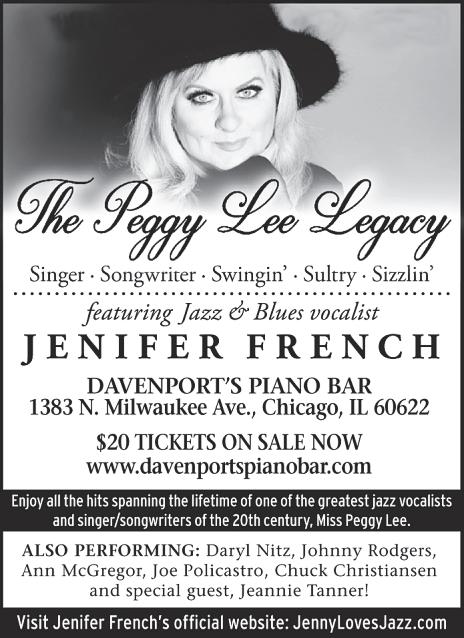
Melodic hardcore isn’t known for indulging pleasantries, and Boston-based five-piece Defeater dare you to enter a universe that’s as bleak as it is complex. Derek Archambault (vocals), Adam Crow (guitar), Jake Woodruff (guitar), Mike Poulin (bass), and Joe Longobardi (drums) write concept albums that tell the story of a Depression-era working-class family as they struggle with adultery, treachery, poverty, and death. Archambault refers to the characters he’s created as his own “Glass family” (a reference to recurring characters in the fiction of J.D. Salinger), and his narratives are inspired by Salinger’s work as well as stories from his grandparents. Literary-minded listeners can follow the story line chronologically, but that’s by no means necessary to enjoy Defeater’s music. In May the band put out their self-titled fi h full-length, the only release in their catalog that tackles multiple character arcs at once. It might seem odd for a band to release their first self-titled album so late in the game, but they seem to be proudly claiming it as their magnum opus—and if they are, they have good reason. Produced by tastemaking engineer Will Yip (Touche Amore, Turnover), Defeater is clean and calculated, and Archambault still spits damnation and salvation in his tightly written lyrics. The narratives don’t overpower the songs as they sometimes did on previous releases; instead they’re complemented by explosive full-band bashes and so er, more methodical guitar lines that lace the underbellies of tracks such as “Desperate.” But even without the stories dominating center stage, Defeater will suck you right into their wretched world. —MADELINE HAPPOLD
Hyde Park Jazz Festival See Saturday. 1-7 PM, various locations in Hyde Park (including Augustana Lutheran Church, Hyde Park Bank, and Rockefeller Chapel), $5 suggested donation per concert. b
Lizzo See Pick of the Week, page 29. Ari Lennox and DJ Sophia Eris open. 8 PM, Aragon Ballroom, 1106 W. Lawrence, $204. 17+
MONDAY30
Caracara 8 PM, Beat Kitchen, 2100 W. Belmont, $12. 17+
If you’re an indie-rock fan with a taste for emo, then the words “Philadelphia band produced by Will Yip” should get your attention. Philly has become a bastion for indie and underground rock this decade thanks to the likes of Yip, a prolific engineer whose studio guidance has helped many of this generation’s best posthardcore bands take flight. In March, Philly four-piece Caracara
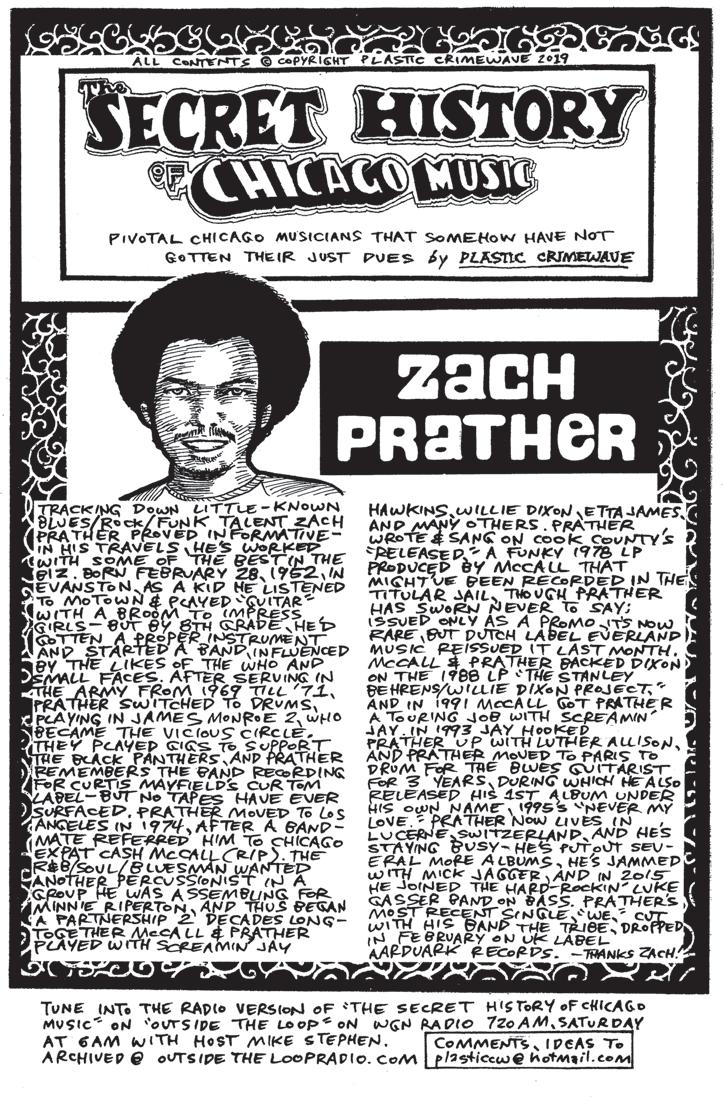
released the EP Better, which Yip not only produced but also released on his Memory Music label. In a just world it would’ve racked up millions of streams in the six months since, just as several other Yip productions already have (Title Fight’s “Head in the Ceiling Fan” has topped fi ve million plays, and Turnover’s “Super Natural” is closing in on 17 million), but Better’s bittersweet epic of a title track still hasn’t hit 100,000. Earlier this year, front man William Lindsay talked to Stereogum about several bands that inspired him to make
Caracara’s music feel like a grand triumphant trek through a valley of shadows—Pianos Become the Teeth, Brutus, Caspian, and Deafheaven. Those infl uences come out in Caracara’s soaring guitars and huge melodies (though they prefer a flawlessly clean sound over murk or distortion) and in Lindsay’s agonized vocals, which lend the music just enough grit to hint at deep wells of anxiety, frustration, and hope. Better is this year’s scene sleeper—Caracara are on the right path, and with any luck, more people will notice soon. —LEOR GALIL

CONVERSATIONS WITH Nick Cave: An Evening of Talk & Music 8 PM, Copernicus Center, 5216 W. Lawrence, sold out. b
Nick Cave has taken many twists and turns during his decades-long career. Though the iconic singersongwriter is first and foremost known for his music, he’s also delved into acting, theater, novels, poetry, and film scores. His latest venture is possibly his most startling and profound deviation yet: ol’ Nick the Stripper now runs a blog called the Red Hand Files where he publicly answers fan mail. He might discuss the sound of God’s voice, field requests from blocked-up songwriters for “spare lyrics lying around,” or reply to heartfelt questions about sexuality, addiction, and the creative process. He’s become a sort of countercultural counselor, and beyond addressing his readers’ issues, he’s been very open about the way that his entire sense of self was ripped apart and re-created following the accidental death of his teenage son, Arthur, in 2015. During that time, Cave was in the midst of writing The Skeleton Tree , his 16th studio album with his band the Bad Seeds. When they began recording in 2016, he commissioned filmmaker Andrew Dominik to document their process, in part to answer the public’s questions about the music and his grief without subjecting himself to a barrage of interviews upon its release. The album and the resulting film, One More Time With Feeling, are stark testaments to the hollowing, mask-stripping effects of sudden loss. For the past year, Cave has been taking the intimate Q&A format of his blog on the road. In programs he’s calling Conversations With Nick Cave: An Evening of Talk & Music, the song-
writer answers questions, takes song requests (which he plays on piano), and generally puts himself out there with a straightforwardness and vulnerability that most other artists who’ve made those qualities their stock-in-trade would be loathe to do. And though Cave is unafraid to confront serious issues, these performances also highlight a quality that’s been underrated over the years: his sense of humor. —MONICA KENDRICK
WEDNESDAY2
Girl Band Ganser opens. 7:30 PM, Beat Kitchen, 2100 W. Belmont, $10. b
On their first full-length, 2015’s Holding Hands With Jamie, Dublin-based four-piece Girl Band perfected high-tension minimalist noise rock. The album’s songs are based on terse rhythms and simple, dissonant guitar loops, which lay the foundation for singer Dara Kiely’s convulsive performances—which always sound like he’s trying as hard as possible to fend off a full-on psychotic break. But on Girl Band’s upcoming second album, The Talkies (Rough Trade), the group seem to be doing their equivalent of taking a deep breath and chilling out. The tracks stretch moods out to the brink of snapping, but the energy is less barreling out of control and more syrupy throb. Girl Band’s new restraint may come as a bit of a surprise to old fans, but even within that less abrasive feel they’ve gotten better at conjuring icky feelings and high-stress sounds. —LUCA CIMARUSTI v


24hrs 10/24, 7 PM, Bottom Lounge b 3.2 featuring Robert Berry, Chris Clark & Kenny Grohowski 10/19, 8 PM, Reggies’ Rock Club, 17+
Academy of Mexican Dance 1/5/20, 5 PM, Thalia Hall b American Authors, Magic Giant 2/18/20, 7 PM, Thalia Hall b Anti-Flag, J. Navarro & the Traitors, Code, Blind Adam & the Federal League 12/20, 8 PM, Reggies’ Rock Club, 17+ Aquadolls 10/18, 7:30 PM, Cobra Lounge b Aweful, Blood People, Dorian Taj 11/30, 9:30 PM, Hideout Meg Baird & Mary Lattimore 10/20, 8:30 PM, Hideout
Bayside, Sincere Engineer 11/7, 8 PM, Bottom Lounge, on sale Fri 9/27, noon, 17+
Black Monastic with Yaw Agyeman, Kiara Lanier, Ben LaMar Gay, Joshua Abrams, ADaD, Charles “Rick” Heath IV, Chris Paquette, Peter CottonTale 11/19, 8 PM, Garfield Park Conservatory, part of Red Bull Music Festival Chicago, 18+ F
Blimes & Gab, Dave B 11/1, 8 PM, Beat Kitchen, 17+
Sarah Borgess & the Broken Singles 12/11, 8 PM, FitzGerald’s, Berwyn, on sale Fri 9/27, 11 AM Broasis (Oasis tribute), Tight Pettyz, DJ Faithful Anchor 10/31, 8:30 PM, Empty Bottle
David Broza and friends
1/14/20, 8 PM, City Winery, on sale Fri 9/27, noon b
Calexico, Iron & Wine 1/291/30/20, 8 PM, Thalia Hall, 17+ Carbon Leaf 10/17, 8 PM, Chop Shop, 18+
Chromeo (DJ set), Goldroom (DJ set), DJ Holographic 12/28, 9 PM, Park West, 18+ Claire & the Bears, Impulsive Hearts, Lauren Anderson 11/19, 8 PM, GMan Tavern Dillinger Four, Modern Life Is War, Arms Alo , C.H.E.W. 11/21, 7 PM, Metro, 18+
Dolly Varden, Frisbie 1/11/20, 8 PM, SPACE, Evanston, on sale Fri 9/27, 10 AM b Dos Santos, Lester Rey, DJ Que.Madre 11/2, 9 PM, Sleeping Village Ensiferum, Kalmah, Abigail Williams, Aenimus 11/19, 6 PM, Reggies’ Rock Club, 17+ Eradicator, Dollar Signs, Wm Covert 10/25, 6 PM, Cobra Lounge b Fee Lion, Kontravoid, Him Hun 10/27, 8:30 PM, Empty Bottle Feminist Happy Hour with Ruth & Ellaine and more 10/5, 6 PM, Empty Bottle, comedy and music event F Fitz & the Tantrums, Twin XL 2/28/20, 8 PM, Riviera Theatre, on sale Fri 9/27, 10 AM b Julia Fordham 5/6/20, 7:30 PM, SPACE, Evanston b Donavon Frankenreiter, Christina Holmes 2/17/20, 8 PM, City Winery, on sale Fri 9/27, noon b Gammer, Riot, Tokyo Machine 11/14, 8 PM, Concord Music Hall, 18+ Freddie Gibbs, Cousin Stizz, Benny the Butcher, Conway the Machine 11/13, 7 PM, Metro, on sale Fri 9/27, 10 AM b
Gramaphone 50: Celebrating 50 Years of Gramaphone Records with Steve “Silk” Hurley, Derrick Carter, Ron Trent, DJ Heather, Colette, JR of the Moleman, G Most, Jesse De La Pena, Justin
Nerf Herder, Copyrights, 12/7, 8 PM, Reggies’ Rock Club, 17+
NF 4/17/20, 8 PM, Aragon Ballroom, on sale Fri 9/27, 10 AM b
Old 97’s Holiday Hoopla! with Caseymagic, Rhett Miller 12/11, 8 PM, Thalia Hall, 17+
Mike Phillips 10/29, 8 PM, City Winery, on sale Fri 9/27, noon b
Nicholas Phillips’ #45miniatures: A Musical Response to Trump 10/6, 8:30 PM, Constellation, 18+
Pile 11/16, 8:30 PM, Empty Bottle
Grace Potter 2/7/20, 8 PM, Riviera Theatre, on sale Fri 9/27, 10 AM, 18+
Rebirth Brass Band 1/17/20, 8:30 PM, Thalia Hall, 17+
Rex Orange County 1/27/20, 7 PM, Aragon Ballroom, on sale Fri 9/27, 10 AM b
Rocket Summer 10/5, 8 PM, Chop Shop, 18+
Aulis Long, Psycho-Bitch, Hector Lopez, and more 11/17, 8 PM, Metro, part of the Red Bull Music Festival Chicago Mark Guiliana’s Beat Music 10/15, 8 PM, SPACE, Evanston b Heidi, DJ Heather 10/11, 10 PM, Smart Bar Marquis Hill/Michael King/ Junius Paul/Makaya McCraven with K-Love & Meaghan McNeil, Kassa Overall 10/30, 8 PM, Lincoln Hall, on sale Fri 9/27, 10 AM, 18+
Il Volo 2/15/20, 8 PM, Chicago Theatre, on sale Fri 9/27, 11 AM b
In Flames, Red, Arrival of Autumn 11/24, 7 PM, Concord Music Hall, 17+
Juan Wauters, Tenci 10/3, 9:30 PM, Hideout
Kayden 11/6, 7 PM, Schubas, on sale Fri 9/27, 10 AM b
Dave Koz and friends 12/13, 8 PM, Chicago Theatre b Jack Larsen 11/19, 7:30 PM, Schubas, on sale Fri 9/27, 10 AM b
Lupe Fiasco 11/21, 8 PM, Riviera Theatre, part of Red Bull Music Festival Chicago, 18+ Madball, Old Firm Casuals, Fear City 12/13, 7 PM, Reggies’ Rock Club, 18+
Makeout 12/12, 7 PM, Reggies’ Rock Club b
Manchester Orchestra, Foxing, Oso Oso 12/4, 7:30 PM, Riviera Theatre, 18+
Masked Intruder, Bombpops, Tight Wire 10/19, 8 PM, Cobra Lounge, 17+
Montana of 300 10/4, 7 PM, the Forge, Joliet b Moonlight Disco featuring Hyphen Hyphen 12/6, 9 PM, Cerise at Virgin Hotels Chicago, on sale Fri 9/27, 10 AM
Mucca Pazza 10/8, 10/15, 10/22, 10/29, 9:30 PM, Hideout
Never miss a show again. Sign up for the newsletter at chicagoreader. com/early

Dan Rodriguez 12/11, 8 PM, City Winery, on sale Fri 9/27, noon b
Saba & Pivot Gang present
John Walt Day with Saba, Joseph Chilliams, MFnMelo, Frsh Waters 11/29-11/30, 7 PM, Metro, part of Red Bull Music Festival Chicago b Schoolboy Q, Nav 11/21, 7 PM, Aragon Ballroom b Sharp/Shock 11/10, 7 PM, Cobra Lounge b Souly Had, 12AM, Foggieraw 12/14, 6 PM, Reggies’ Rock Club b Sports Team 10/31, 7 PM, Cobra Lounge b Riva Starr, Ferrick Dawn, and more 11/22, 10 PM, Smart Bar Tedeschi Trucks Band 1/171/18/20, 7:30 PM; 1/24-1/25/20, 7:30 PM, Chicago Theatre, on sale Fri 9/27, 10 AM b Tennis System, Suburban Living 11/13, 8 PM, Subterranean, 17+
The Things You Gave Me with Alex Jenny, J Bambii, Winter Sherrod, Bonita Appleblunt 10/14, 8 PM, Subterranean, 17+ Thrice, Mewithoutyou, Drug Church 1/31/20, 6 PM, Concord Music Hall, 17+ Through the Roots, Pacific Dub 10/16, 8 PM, Beat Kitchen, 17+ Tierra Whack 11/26, 8 PM, Concord Music Hall, part of Red Bull Music Festival Chicago, 18+ Tora Tora 10/6, 7:30 PM, the Forge, Joliet b Torche, Eye Flys, Rlyr 11/15, 8:30 PM, Empty Bottle
Trashcan Sinatras 10/22, 8 PM, SPACE, Evanston b Unknown New, Oh Yeahs 1/7/20, 7:30 PM, SPACE, Evanston b Midge Ure 1/29/20, 8 PM, City Winery, on sale Fri 9/27, noon b
Wet Wallet, Stander, Graphics 10/8, 8:30 PM, Empty Bottle JJ Wilde 11/14, 7:30 PM, Cobra Lounge, 17+ Webb Wilder & the Beatnecks 1/11/20, 8 PM, FitzGerald’s, Berwyn, on sale Fri 9/27, 11 AM Kamaal Williams 11/29, 9 PM, Lincoln Hall, 18+ Jamila Woods 11/27, 8 PM, the Geraghty, part of Red Bull Music Festival Chicago, 18+ Yola, Amythyst Kiah 1/14/20, 8 PM, SPACE, Evanston b Zero Fatigue with Smino, Monte Booker, and more 11/23, 9 PM, Thalia Hall, part of Red Bull Music Festival Chicago, 18+
Temples, Art d’Ecco 1/31/20, 8 PM, Lincoln Hall, new date; moved to Lincoln Hall, 18+
Actors, Bootblacks, New Canyons, Bellwether Syndicate DJs 10/20, 8:30 PM, Empty Bottle
Jonathan Bree 10/27, 9 PM, Sleeping Village Bridal Party, Little Church 10/6, 8:30 PM, Hideout Teri Bristol, Psycho-Bitch 10/18, 10 PM, Smart Bar Mary Chapin Carpenter & Shawn Colvin 10/18, 8 PM, Athenaeum Theatre b Slaid Cleaves 10/17, 8 PM, FitzGerald’s, Berwyn Michael Franti & Spearhead 10/24, 8 PM, Concord Music Hall, 18+
Kazu 10/12, 8:30 PM, Constellation, 18+
Legendary Pink Dots, Orbit Service 10/4, 8 PM, Beat Kitchen Little Feat 10/13, 8 PM, the Vic, 18+
Roscoe Mitchell, Moor Mother 12/12, 7:30 PM, Fullerton Hall, Art Institute of Chicago b Angel Olsen, Vagabon 11/14, 7:30 PM, Riviera Theatre, 18+ Shintaro Sakamoto 10/18, 8 PM, Subterranean, 17+
Bob Seger & the Silver Bullet Band 10/19, 8 PM, United Center b Richard Shindell 10/12, 8 PM, Szold Hall, Old Town School of Folk Music b Sarah Shook & the Disarmers, Senora May 10/11, 10 PM, Sleeping Village v
A furry ear to the ground of the local music scene
SINCE DEBUTING in 2015, local electronic duo Grün Wasser —aka vocalist Keely Dowd and producer Essej Pollock have steadily broadened their apocalyptic EBM by adding new sounds. On Friday, October 4, they drop the new album Not OK With Things (on vinyl and cassette via Texas label Holodeck Records), and it’s easily their most diverse work yet. Advance tracks “Stranger’s Mouth” and “Driving” bristle with nervous energy, suspended between subtle pop hooks, chilly synth tones, and scattered drum patterns. On Thursday, October 3, Grün Wasser play a release show at Sleeping Village with openers Ariel Zetina and Material and a DJ set from Cid Ikarus.
On Friday, September 27, the Chicago South Side Film Festival opens its ten-day run with a night devoted to the history of house music! Raven’s Place in Blue Island hosts a screening of the documentary House Music: The Real Story by producer Jesse Saunders, who’s o en claimed that 2019 is the 35th anniversary of house— because in 1984 he released his debut single, “On and On,” widely considered the first house record. This wolf suspects the film will dive into the backstory of that 12-inch! A er the screening, house veterans Shawn Christopher , Keith Nunnally , and Sundance perform live; Alan King , Mike Dunn, and Lori Branch spin DJ sets. The event starts at 9 PM; tickets are $25 in advance, $35 at the door.
Gossip Wolf craves the delightful feeling of being a hometown tourist—and that itch is best scratched when two local institutions unexpectedly come together! On Friday, September 27, house-music legend Farley “Jackmaster” Funk DJs the 21-and-over Shedd Aquarium party series Shedd After Hours . The dance floor will start grooving at 6 PM, but you need to nab tickets online or at the Shedd before 4:15 PM that day—otherwise you’ll miss the dolphins performing their famous synchronized dance to “Love Can’t Turn Around”! —J.R. NELSON AND LEOR GALIL
Got a tip? Tweet @Gossip_Wolf or e-mail gossipwolf@chicagoreader.com.









Xfi nity xFi gives you the fastest speeds and the best in-home WiFi experience. See who’s online, set curfews and pause your WiFi to bring the family together. Xfi nity xFi puts you in control. Now that’s simple, easy, awesome. Go to xfi nity.com, call 1-800-xfi nity or visit an Xfi nity Store today
chicagoreader.com/ VOTE We know you love Chicago, now tell us why! Vote for your favorite places, people, and things to do in this city, and they could be featured in the Reader’s special Best of Chicago issue this November.
Your Republican dad’s cross-dressing isn’t something you need to talk about with him.
By DAN SAVAGE
Q : I’m a 35-year-old bisexual man in a LTR with a man. My question, however, has to do with my parents. As an adolescent/teen, I was a snoop (as I think most of us are, looking for dad’s porn stash, etc). I was probably 12 or so when I found evidence of my dad being a cross-dresser. There were pictures of him in makeup and women’s clothing, and correspondence (under an alias and to a separate PO box) with other men interested in cross-dressing. As far as I could tell, he did this alone in hotel rooms while on work trips. Two years ago while on vacation, it came up while my mom and I were at dinner. She had recently found evidence, and she needed to take a short break to visit a friend out of state to process. She suggested I bring it up with him (I guess) because I’m queer and she knows I used to help host pansexual play parties. My dad is a devout Republican and comes off as very masculine. I see them only a couple times a year. Should I try to bring this up with my dad and let him know that I’ve known about his cross-dressing for more than 20 years and offer my knowledge about kink and alternative sexuality? Or just let him do his thing and we all retain the illusion of ignorance? My parents are still happily married— and whether it is more companionate than lusty, they love each other and have been married for more
better for everyone if your dad had been open about his cross-dressing with his wife and kid(s), that ship sailed a long time ago.
than 40 years. Your take would be appreciated. —S ON OF A CROSS-DRESSER
A : Why does your mother want you to talk to your dad about his cross-dressing? Does she want you to talk him out of it? Does she want you to convince him to include her on his crossdressing trips? Does she think he would benefit from attending a pansexual play party with his adult bisexual son?
Unless your father is in some sort of emotional distress or your mother is in some sort of danger, I really don’t see the point of this conversation, SOACD. It doesn’t sound like your dad is struggling with shame. If your dad had to abuse alcohol or smoke a crate of meth in order to give himself permission to cross-dress alone in a hotel room, you surely would have mentioned that fact.
From the details you included in your letter, SOACD, it sounds like your dad has successfully integrated cross-dressing into his life without harming himself or neglecting and endangering your mom. You could say your parents had a long and loving marriage despite the cross-dressing . . . or you could say it’s possible your parents’ marriage is an ongoing success not despite the cross-dressing but because of it. (It’s too bad it didn’t make him a better person politically, but you can’t have everything.) And while it might have been
I don’t see what this convo—coming 20 years after you discovered his cross-dressing and two years after your mother discovered it—will achieve other than embarrassing and humiliating your father. Your parents’ long, loving, successful marriage coexisted with your father’s cross-dressing for four decades, and I don’t see why it can’t continue to coexist with it now. And if your mother is sad that your dad never shared this with her and wants to reassure him that he didn’t need to hide this part of himself from her and that she loves him just the same, she doesn’t need to deputize her bisexual son to initiate that conversation. If she thinks it would be a relief and not a torment for her husband to know she knows and that knowing hasn’t changed how she feels about him, she should tell him.
Q : I’m 25 years old and polyamorous. I’m in a relationship with a 28-yearold man since August 2018. It was just him and me when we first started dating, and then his old flame came into the picture. This whole time he had said he was not interested in having kids and a home and a primary partner. Since he got surgery in June and is now unemployed, he’s had a lot of time to think, he says, and now he’s decided he wants kids and a home and a primary partner. He knows I do not want any of these things, so he says his old flame is the person he’s going to do this with. He has made jokes about being an “alcoholic” since I first met him, and I thought it was just a joke. But now he’s spending money he simply does not have on alcohol. It worries
me. Do I hang in there? Do I throw in the towel? I love this man very much, but I’m so confused. —P REVIOUSLY THE PRIMARY
A : I’m so sorry, PTP, but it would appear you’ve lost the unemployed guy with the drinking problem to another. But take heart: You’re young enough to meet someone else, someone who wants what you want and doesn’t want what you don’t. I’m certain that a er meeting this person—or even long before you meet them— you’ll be able to recognize that your ex did you a favor. Sometimes we dodge the bullet, PTP, but on rare occasions the bullet dodges us.
Q : My 19-year-old younger brother is doing financial domination online. He maintains a Twitter account that’s mostly photos of him giving the finger and looking smug. He also posts pics of his feet, videos of

him urinating (no penis visible, just the stream), and lots and lots of “bitch shots,” i.e., crotch-height photos looking up at him from below. He uses a lot of homophobic slurs in the tweets that accompany these images. I would have exactly zero fucks to give about this if my brother wasn’t still a teenager and wasn’t posting photos of his face. I warned him that the Internet is forever, and that facial-recognition so ware is a thing, and that people who don’t understand the role-play aspect of his use of hate speech will think he’s a bigot. This could come back to haunt him socially or professionally. Complicating matters somewhat, my little brother is a straight boy and I’m gay. He’s not making a ton of money doing this, but he’s making enough that my parents are wondering how he’s buying all those superexpensive shoes. What do I tell him? What do I tell them? —FALLING INTO

A : You’ve already told your brother the Internet is forever and the low-key, low-stakes pseudo sex work he’s doing could come back to haunt him, FINDOMS. Beyond that . . . well, there’s really not much more you can do. Your brother is an adult, as are the men paying “tribute” to him, as they say in FinDom/FinSub Twitter, and he’s free to make his own choices. As for your parents, why is explaining where your brother is getting all those new shoes your problem? If your brother is old enough to set up his own Twitter and Venmo accounts, he’s old enough to come up with a plausible lie about those shoes. v
Send letters to mail@ savagelove.net. Download the Savage Lovecast every Tuesday at savagelovecast. com.
@fakedansavage















ADMINISTRATIVE SALES & MARKETING FOOD & DRINK
SPAS & SALONS
BIKE JOBS
RENTALS FOR SALE NON-RESIDENTIAL ROOMATES
The Northern Trust Company seeks an Associate Quantitative Portfolio Manager to manage day-to-day activities and strategies of portfolios to meet client financial objectives within specified guidelines, regulatory framework, and corporate policies. Manage cash, client activity, futures and corporate actions. Work with lead portfolio manager to create and execute necessary trades. Work with support partners in operations and middle office to resolve issues related to exceptions, accounting issues, or discrepancies to ensure portfolio management information is accurate. Assist portfolio managers and management as needed with presentations and special projects. Build and maintain portfolio management tools used to analyze and research quantitative active investment strategies. Create and interpret client portfolio performance reports and respond to client inquiries regarding portfolio and investment strategy performance. Develop risk exposure and attribution analysis reporting solutions using Python and Oracle SQL. Research and back-test investment strategies using SAS or R. Position requires a Master’s degree in Finance, Risk Management, Mathematics, or a related field, and 2 years of experience in performing quantitative fi nance in risk analysis or banking setting. Experience must include a minimum of: 2 years of experience creating and interpreting portfolio performance reports and responding to inquiries regarding performance of strategies and portfolios; 2 years of experience performing quantitative analysis, including trend analyses, impact analyses, and portfolio attribution analyses, using SAS or R; 2 years of experience researching, developing, implementing and backtesting quantitative methodologies and strategies, using SAS or R; 2 years of experience processing large datasets and performing analytics using data management, data visualization and statistical analysis software including SAS Enterprise Guide, SQL, and VBA; and 2 years of experience working with middle office and operations team to resolve issues of exceptions and discrepancies with data. Job location: Chicago, IL. To apply please visit https:// careers.northerntrust. com and enter job code 19084 when prompted. Alternatively, please send your resume, cover letter, and a copy of the ad to S. Saultz, 2160 E. Elliot Road, Tempe, AZ 85284. (09/26)
adoption & accuracy of existing products as well as developing new BI & Analytics solutions. Apply at www.grouponcareers. com by searching keyword R21986 (09/26)
ASSOCIATE DATA
SCIENTIST
Catalina Marketing Corporation has an opening in Chicago, IL for an Associate Data Scientist. Spprt advncd prdctve mdling intiatves that algn w/ bsnss objctvs. To apply please send a resume to: Catalina, Attn.: R. Calvin, 200 Carillon Parkway, St. Petersburg, FL 33716. Must respond with job requisition number 4438311 (09/26)
TransUnion, LLC seeks Consultants for Chicago, IL location to independently collaborate w/internal & external customers, sales associates, & team members. Master’s in Comp. Sci./Comp. Eng./ any Eng. field + 2yrs exp. or Bachelor’s in Comp. Sci./ Comp. Eng./any Eng. field + 5yrs exp. req’d. Req’d skills: software analysis/ development exp. working on multiple projects (8-10) simultaneously; analyzing credit industry trends; & w/ETL tools (Ab-Initio) incl. Transform, Partition, Departition, Dataset; writing scripts to create new tables, views, queries; Unix/Linux, scripting (Unix, Korn, Bourne), Control M, Salesforce, Buildforge, Clarity, Data Gateway, Autosys, DB2/ Oracle databases, SQL Server Queries, DB2 SQL, Netezza, Agile. 20% telecommuting permitted. Send resume to: R. Harvey, REF: SSN, 555 W Adams, Chicago, IL 60661 (09/26)
TransUnion, LLC seeks Analysts, Analytics for Chicago, IL location to support multiple projects & deliver analytical products. Master’s in Statistics/ Applied Mathematics/ Predictive Analytics/related Quantitative field + 1yr exp. req’d. Req’d skills: exp. performing segmentation & statistical analyses on large population sets, & w/SAS, R, Python on Linux, SQL, AbInitio, GLM, visualization, logistic regression & timeseries analyses, scenario & sensitivity analysis, machine learning to analyze big data. Send resume to: R. Harvey, REF: ZL, 555 W Adams, Chicago, IL 60661 (09/26)
REF: PBJ, 555 W Adams, Chicago, IL 60661 (09/26)
TransUnion, LLC seeks Sr. Analysts, Analytics for Chicago, IL location to independently design & execute all aspects of statistical analytics projects for predictive modeling, business reporting & customer evaluations. Master’s in Statistics/ Mathematics or Analytics/ Risk or Operations Research/Management or related Quantitative field +2yrs exp. or Bachelor’s in Statistics/Mathematics or Analytics/Risk or Operations Research/ Management or related Quantitative field +5yrs exp req’d. Req’d skills: SAS, R, SAS macros, SQL, Python and Natural Language Processing, scripting languages, SQL queries for data extraction, Unix Command, Tableau, data visualization, MS VBA, Dimensionality reduction techniques (feature selection, feature extraction, and stratified sampling), cluster analysis & variable selection, factor analysis for high risk customer behavior. Send resume to: R. Harvey, REF: SL, 555 W Adams, Chicago, IL 60661 (09/26)
60% telecommuting permitted. Send resume to: R. Harvey, REF: DN, 555 W. Adams St., Chicago, IL 60661 (09/26
TransUnion, LLC seeks Sr. Consultants for Chicago, IL location to design, implement, upgrade & maintain sw applications for business processes. Master’s in Comp Sci/ Comp Applications/Comp Eng/any Eng field + 3yrs exp. or Bachelor’s in Comp Sci/Comp Applications/ Comp Eng/any Eng field + 5yrs exp. req’d. Req’d skills: Java development, supporting TeamSite/ LiveSite CMS, OpenDeploy, JavaScript, CSS, HTML/ XML, responsive/adaptive design, Tomcat, Struts, Spring, Hibernate, Maven, XSLT. 20% telecommuting permitted. Send resume to: R. Harvey, REF: SRA, 555 W Adams, Chicago, IL 60661. (09/26)
60626. (09/26)
GEOGRAPHER CBRE, Inc. has an oppty in Chicago & Oak Brook, IL for a Project Mgr – Must wrk at both locatns. Mail resume to Attn: HR, 2100 Ross Ave, Ste 1600, Dallas, TX 75201; Ref #CHIJGR. Must be legally auth to work in the U.S. w/o spnsrshp. EOE (09/26)
Large studio apartment near Morse red line. 6826 N. Wayne. Hardwood floors. Pets OK. Heat included. Laundry in building. Available 11/1. $850/month. (773)761-4318. www. lakefrontmgt.com. (09/26)
1 BEDROOM
INSTRUCTION MUSIC & ARTS
NOTICES
MESSAGES
LEGAL NOTICES
ADULT SERVICES
Groupon, Inc. is seeking a Technical Product Manager in Chicago, IL w/ the following responsibilities: mng data needs for various business lines & be a champion for
TransUnion, LLC seeks Lead Engineers for Chicago, IL location to assess, develop, design & architect high volume, high concurrency software applications. Master’s in Comp Sci./Comp Eng./ any Eng. field + 3yrs exp. or Bachelor’s in Comp Sci./Comp Eng./ any Eng. field + 5yrs exp. req’d. Req’d skills: sw design, architecture exp. w/high volume, high concurrency software applications; Java, Spring, Git, Maven, Jenkins, Confluence, SonarQube, AWS/Cloud platforms, Linux, DevOps, Big data; container technologies (Docker, Kubernetes), Enterprise Connection Manager tool. Send resume to: R. Harvey,
TransUnion, LLC seeks Consultants for Chicago, IL location to independently develop complex sw test plans, execute all test plans, and validate batch fulfillment system setup and output data and resolve critical software development batch issues. Master’s in Comp. Sci. or Comp./Management Info. Systems + 2yrs exp. or Bachelor’s in Comp. Sci. or Comp./Management Info. Systems + 5yrs exp. req’d. Skills Req’d: sw development, maintenance, integration, testing & migration to new system & using C#, C++, Git; requirement gathering, ETL design & implementation; automating model execution processes; complete SDLC exp.; resolving critical sw development batch issues; developing POC for sw models using JAVA; .NET framework, SQL queries, Ab-Initio, Maven/Hibernate, analytics tool creation and statistical model development, R, SAS, standard Open systems applications, LINUX, UNIX, FTP/FileZilla, SQL, Visual Studio, Eclipse Neon. 40% telecommuting permitted. Send resume to: R. Harvey, REF: ST, 555 W Adams, Chicago, IL 60661 (09/26)
TransUnion Interactive, Inc. (a wholly owned subsidiary of TransUnion, LLC) seeks Sr. Analysts for Chicago, IL location to design, implement, maintain, & deliver sw applications & IT infrastructure. Master’s in Comp. Sci./Comp. Eng. + 2yrs exp. or Bachelor’s in Comp. Sci./Comp. Eng. + 5yrs exp. req’d. Skills req’d: exp. in a customer-facing role w/sw development/ application delivery using B2B integration tech. (WebMethods, SAP XI/PI middleware, XML, IDOC, xCBL, EDI formats); SQL query; XSLT; Sharepoint; Jira; ASP.net; Visio; Java.
WANT TO ADD A LISTING TO OUR CLASSIFIEDS? E-mail salem@chicagoreader.com with details or call (312) 392-2970
Sr. Trading Platform Engineer needed by Peak6 Group, LLC in Chicago, IL to review, analyze, develop & implement Trading Platform SW solutions. Reqs bachelor’s, or foreign equiv., in Comp. Sci, or related field, & 3 yrs. exp. developing & engineering financial industry data processing SW app. dealing with US Equities & Options. Exp. must include dev’t of financial data processing app, & work with Java, JavaScript, Golang, Python, Redis, Microsoft SQL Server, & PostgreSQL. To apply, mail resume to: K. Hilgart, Peak6 Group, LLC, 141 W. Jackson Blvd, Suite 500, Chicago, IL 60604 (09/26)
Poder Learning Center seeks Program Support Specialists in Chicago, IL to maintain QuickBooks database incl. account payables & receivables for non-profit org. Identify & secure community partnerships with local orgs & edu institutions to provide new student referrals within Spanishspeaking community. Req’d: Bachelor’s degree in social work, financial management, bus admin or rel & 3 years of relevant work exp. Fluent in Spanish. If qualified, email resume to Griselda Piedra at gpiedra@ poderworks.org. (09/26)
Northwestern University seeks Psychologist for Evanston, IL location. PhD or Psy.D in clinical or counseling psychology from an APA accredited academic program + 1yr exp. req’d. Req’d skills: Completion of 1yr predoctoral internship at an APA accredited academic site. 1yr exp. working in comprehensive university counseling center, must incl. working w/Asian/Asian American students on campus, incl. psychological assessments, individual & group therapy, crisis intervention & outreach preventative programs. Exp. providing clinical supervision. Must be Licensed or License Eligible in Illinois. Must be fluent in Mandarin. After hours on-call rotation req’d. Send resume to: John H. Dunkle, REF: QZ, 633 Emerson Street, Evanston, IL 60208. (09/26)
MANUFACTURING ENGINEER (location: Chicago, IL); mail resume to Kathy Bennett, S&C Electric Company, 6601 N Ridge Blvd, Chicago, IL
Systems Administrator Install, configure, and support clients local area network (LAN), wide area network (WAN); monitor network to ensure network availability to clients system users and perform necessary maintenance to support network availability; maintain and administer computer networks and related computing environments, including computer hardware, systems software, applications software, and all configurations; add users to a network, and assign and update security permissions on the network; recommend changes to improve computer or information systems; document network and systemrelated activities or tasks; test computer hardware and software performance; windows server 2012 and 2016 configuration and troubleshooting; perform data backups to prevent loss of information; keep client environments patched and secure; maintain the inventory of equipment for clients; collaborate with technicians to resolve information technology issues; plan, coordinate, and implement network security measures to protect data, software, and hardware; administrate infrastructure, including firewalls, switches, servers and malware protection software; and update knowledge about emerging industry or technology trends; For 1-2 times per week, employee is required to travel to customers’ place of business to perform some of his/her on-site job duties. Assignments will last 2-4 hours. All customers are located in Cook County Illinois. Mail résumé to Bruce Sokol, Clear Corp., 409 W. Huron St, Lower Level, Chicago IL-60654 (09/26)
StarLab Corp. needs a Medical Technologist. Mail resume to HR - 9213 Parklane Ave Franklin Park, IL 60131 (09/26)
Sunny Andersonville studio apartment, modern kitchen/bath, eat in dining/ bar area, mini blinds, washer/dryer, garage option, no dogs. OCT 1. $545. 708-482-4712. (10/03)
Large studio apartment near Loyola Park. 1337 W. Estes. Hardwood floors. Cats OK. Heat included. Laundry in building. Available 9/1. $850-880/ month. Sublease from 10/1/19 through 3/31/20 available for $765/month. (773)761-4318. www. lakefrontmgt.com (09/26)
Bucktown. One bedroom apartment. 2427 W Lyndale. $600/m. Call Edward (312) 320-6484 (09/26)
One bedroom apartment near Warren Park and Metra. 6802 N. Wolcott. Hardwood floors, Laundry in building. $995-1050/ month, Heat included. Cats OK. Available 11/1. (773)761-4318. www. lakefrontmgt.com (09/26)
Large one bedroom apartment near Loyola Park. 1335 W. Estes. Hardwood floors. Cats OK, Laundry in building. $995/ month. Heat included. Available 11/1. (773)7614318. www.lakefrontinet. com (09/26)
Large one bedroom apartment near Morse red line 6824 N. Wayne. Hardwood floors. Pets OK. Heat included, Laundry in building. Available 11/1. $1025/month. (773)7614318. www.lakefrontmgt. com (09/26)
2 BEDROOM
Large 2 BR/1 BA apartment near RUSH/ UIC Med. 1628 W. Adams. Laminate floors, new bathroom, parking, tenant utilities, laundry in building. $2050/month. Available immediately. (847)8679275. (10/03)
3 BEDROOM
Large 3 bedroom, 2 bath apartment near Wrigley Field. 3820 N. Fremont. Hardwood floors. Cats OK. Laundry in building. Available 11/1. $2225/ month. (773)761-4318 www. lakefrontmgt.com (09/26)
FOR SALE
Private waterfront home with sand beaches on Lake Michigan. View pictures at www. newkewauneerealestate. com $374,000.00 N.E.W. Real Estate, Inc. Kewaunee, WI (920) 388-1004 (09/26)

GENERAL
FOR SALE
NOTICE OF PUBLIC SALE to satisfy the owner’s moving lien. H2H Movers will sell at public lien sale on September 28, 2019, the personal property in the below listed unit, which may include but not limited to household and personal items. The public sale of these items will begin at 10:00 AM on storageauctions. com and continue until the unit is sold. PUBLIC STORAGE 1916 N Elston Ave, Chicago, IL 60642, Unit D571. Karen Minogue – Glassware and dishware, vases, china cabinet, bed
w/ mattress & box spring, bookshelf, pictures, night stand, dresser, clothes and shoes. All sales are subject to cancellation. We reserve the right to refuse any bid. Payment must be in cash or credit card (3% surcharge will apply), no checks. (09/26) SERVICES
Miracle Message. Obtain health, energy and joy. Prolong your youth and life. Decrease illness with the possibility of healing. Call Jolanta: (847)6408989. 5237 W. Addison St. Chicago, IL 60641 (10/10)
Danielle’s Lip Service, Erotic Phone Chat. 24/7. Must be 21+. Credit/ Debit Cards Accepted. All Fetishes and Fantasies Are Welcomed. Personal, Private and Discrete. 773935-4995 (09/26)
52 year old incarcerated Black/Italian male seeks sincere, down to earth and genuinely open-minded people (like myself) to correspond with. All welcome, I can’t wait to share my story and learn about yours. Peter Saunders #B–001182600 N. Brinton Avenue Dixon, Illinois 61021

LEGAL NOTICE
STATE OF ILLINOIS, PUBLICATION NOTICE OF COURT DATE FOR REQUEST FOR NAME CHANGE. Location Cook County District 2- County Division - Case Type: Name Change from Matthew Radzik to Maciej Radzik Case Initiation Date 09/03/2019 Court Date 11/06/2019, 9:00 AM in Courtroom #0204 Case # 20192003712 (09/26)
Notice is hereby given, pursuant to “An Act in relation to the use of an Assumed Business Name in the conduct or transaction of Business in the State, “as amended, that a certification was registered by the undersigned with the County Clerk of Cook County, Registration Number: Y19002080 on August 30, 2019. Under the Assumed Name of Mo’Hawk The Mixher Mobile Bartending Services with the business located at 3145 W Flournoy, Chicago, IL 60612. The true and real full name(s) and residence address of the owners(s)/ partner(s) is: Owner/Partner Full Name: Monique Rolling Complete Address: 3145 W Flournoy, Chicago, IL 60612 (09/26)
Notice is hereby given, pursuant to “An Act in relation to the use of an Assumed Business Name in the conduct or transaction of Business in the State, “as amended, that a certification was registered by the undersigned with the County Clerk of Cook County, Registration Number: Y19002080 on
Monique
3145 W Flournoy,
(10/10)
ILLINOIS,
DATE FOR REQUEST FOR
CHANGE. Location Cook County - County DivisionCase Type: Name Change from Saidah Annitra Davis to Saidah Annitra Adjoa Akun Court Date 1112/2019, 9:30 AM in Courtroom #1702 Case # 2019CONC001178 (10/03)
OF ILLINOIS, PUBLICATION NOTICE
COURT DATE FOR REQUEST FOR NAME CHANGE. Location Cook County - County DivisionCase Type: Name Change from Juan Jesus Velazquez Jacobo to Nathan Velazquez Filed 09/18/2019 Court Date 11/19/2019, 1:00 PM in Courtroom #1704 Case # 2019CONC001180 (10/10)
Notice is hereby given, pursuant to “An Act in relation to the use of an Assumed Business Name in
the conduct or transaction of Business in the State,” as amended, that a certification was registered by the undersigned with the County Clerk of Cook County. Registration Number: Y19002152 on September 13, 2019. Under the Assumed Business Name of SCP NEWSPAPER SALES. with the business located at: 2622 E 83RD STREET, CHICAGO, IL 60617. The true and real full name(s) and residence address of the owner(s)/ partner(s) is: Owner/Partner Full Name Complete Address SCOTT PARKER 2622 E. 83RD STREET, CHICAGO, IL 60617 (10/10)
I N THE SUPERIOR COURT OF THE STATE OF WASHINGTON IN AND FOR THE COUNTY OF KING, JUVENILE DEPARTMENT IN RE THE DEPENDENCY OF: TIE’LAJIAH PITTMAN DOB: 03/15/13 NO: 19-7-01908-3 KNT NOTICE OF HEARING
TO: * Nicholas Pittman, Alleged Father; Unknown Father, and/or anyone claiming parental/ paternal rights or interest in the child and to All Whom It May Concern:
On June 21, 2019, a petition for Dependency was filed in the above entitled Court, pursuant to RCW 13.34.080 and/or RCW 26.33.310 regarding the above named child, whose parents are
Tiesha Turner and *. [FOR FURTHER INFORMATION, CALL 253372-5738, 8:00 a.m. - 4:30 p.m.]
Said Petition will be heard on October 29, 2019, at the hour of 8:15 a.m., at King County Superior Court, Juvenile Department, 401 4th Ave North, Kent, WA 98032, before a judge of the above entitled court, at which time you are directed to appear and answer the said petition or the petition will be granted and action will be taken by the court such as shall appear to be for the welfare of the said child.
Dated September 3, 2019
BARBARA MINER
KING COUNTY
SUPERIOR COURT CLERK BY: AMD, Deputy Clerk (09/26)
STATE OF INDIANA ) IN THE LAKE SUPERIOR COURT JUVENILE DIVISION, CROWN POINT. INDIANA. ) SS:
COUNTY OF LAKE ) Cause Number: 45D061902AD000028. Lake County (Quest). Filed: 2/12/2019 3:43 PM. Clerk Lake County, Indiana.
IN RE THE ADOPTION OF: TRENT MOLINA, a minor child. MARY JANE STRAUBEL, Petitioner. And THOMAS E. STRAUBEL, Petitioner.
SUMMONS AND NOTICE OF ADOPTION BY PUBLICATION
To the Biological Father, JUAN MOLINA, upon and against all persons claiming from, through or under them, and any other person who may be concerned: You are hereby notified that a petition for adoption of TRENT MOLINA has been filed in the office of the clerk of the Lake County Superior Court, Juvenile Division, located at 3000 W. 93rd Avenue, Crown Point. Indiana 46307.
If you seek to contest the adoption of the child, you must file a motion to contest the adoption in accordance with I.C. 31-1910-1 in the above named court not later than thirty (30) days after the last date of publication of this notice. If you do not file a motion to contest the adoption within thirty (30) days after the last date of publication of this notice the above named court will hear and determine the petition for adoption. Your consent to the adoption will be irrevocably implied and you will lose the right to contest either the adoption or the validity of your implied consent to the adoption. No oral statements made to you relieve you of your obligations under this notice. This notice complies with 1.C. 31-19-4.5-3 but does not exhaustively set forth a person’s legal
obligations under the Indiana adoption statutes. A person being served with this notice should
Date: FEB 20 2019
Lorenzo Arredondo Clerk of the Lake County Courts
Attorney for Petitioners
Robert A. Plantz Ind. Atty. No.: 22104-64
8105 Georgia Street
Merrillville, Indiana 46410
Telephone: (219) 942-3710 (10/10)




























